A publication of

BONEFISH & TARPON






Editorial Board
Dr. Aaron Adams, Harold Brewer, Sarah Cart, Bill Horn, Jim McDuffie
Publication Team
Publishers: Harold Brewer, Jim McDuffie
Editor: Nick Roberts
Editorial Board
Advertising Coordinator: Henry Buck
Dr. Aaron Adams, Harold Brewer, Bill Horn, Jim McDuffie
Layout and Design: Scott Morrison, Morrison Creative Company
Contributors
Publication Team
Aaron Adams, Ph.D.
Publishers: Harold Brewer, Jim McDuffie
Benjamin M. Binder
Ross Boucek, Ph.D.
Managing Editor: Alex Lovett-Woodsum
Jacob Brownscombe, Ph.D.
Consulting Editors: Bob Baal, Nick Roberts
Joe Evans
Layout and Design: Scott Morrison, Morrison Creative Company
Tony Fedler, Ph.D.
Advertising Coordinator: Mark Rehbein
Pat Ford
Tony Goldberg, Ph.D.
Matthew Kimball, Ph.D.
Photography
Steven Lombardo
Cover: Tosh Brown
Kris Millgate
Aaron Adams
Marc Montocchio
Jacob Brownscombe
T. Edward Nickens
James Buice
Rolando O. Santos, Ph.D.
Jacqueline Chapman
Dan Decibel
Photography
Pat Ford
Cover: Pat Ford
Dr. Zack Jud
Aaron Adams, Ph.D.
Frankie Marion
Omar Arceo
The Bonefish Bonnies
Scott Morrison
Marjorie Shropshire
Cody Eggenberger
Fly Lords
Ariel Wile
Alex Lovett-Woodsum
Pat Ford
Ed Glorioso
Contributors
Officers (*Executive Committee)
Tony Goldberg, Ph.D.
IGFA
Aaron Adams, Ph.D.
Masa Katsumata
Christine Beck
Jim Klug
Brooke Black
Justin Lewis
Jacob W Brownscombe, Ph.D.
Steven Lombardo
James Buice
Jiangang Luo, Ph.D.
Tom Karrow
Marc Montocchio
Alex Lovett-Woodsum
Scott Morrison
Jonathan Olch
Jordan Pate
Harold Brewer, Chairman of the Board, Key Largo, Florida*
Bill Horn, Vice Chairman of the Board, Marathon, Florida*
Jim McDuffie, President, Coral Gables, Florida*
Tom Davidson, Chairman Emeritus, Key Largo, Florida*
Russ Fisher Vice Chairman Emeritus, Key Largo, Florida*
Matt Connolly, President Emeritus, Hingham, Massachusetts* Bill Stroh, Managing Director, Florida Keys, Florida*
Luis Menocal, Managing Director Cuba, Palmetto Bay, Florida*
Bill Klyn, Co-Chair of Membership, Jackson, Wyoming*
Robbie Roemer
Jennifer Rehage, Ph.D.
Jeff Harkavy, Strategic Relationships, Secretary, Coral Springs, Florida*
Patrick Williams
Nick Roberts
Rolando Santos, Ph.D.
Aaron Adams, Director of Science and Conservation, Melbourne, Florida*
Bonefish & Tarpon Journal
Jon Shenker, Ph.D.
2937 SW 27th Avenue
Liz Wallace, Ph.D.
Stu Apte Tavernier, Florida
Suite 203 Miami, FL 33133
JoEllen Wilson
Rodney Barreto
Gables, Florida
2019 Events
Bonefish & Tarpon Journal
BTT in New Orleans
135 San Lorenzo Ave. • Suite 860 Coral Gables, FL 33146
Thursday, September 26, 2019
Audubon Aquarium of the Americas
2017 Fundraising Events
BTT in Atlanta
Naples, FL – January 11, 2017
Wednesday, October 30, 2019
Boca Grande, FL – February 3, 2017
The Burge Club
New York, NY – March 14, 2017
Dan Berger
Bob
Virginia
BTT 7th International Science Symposium
Islamorada, FL – March 30 2017
November 13 – 14, 2020
6th International Symposium, Weston, FL –November 10-11, 2017
Bonaventure Resort & Spa Weston, FL
BTT’s Mission
BTT’s Mission
To conserve and restore bonefish, tarpon and permit fisheries and habitats through research, stewardship, education and advocacy.
To conserve and restore bonefish, tarpon and permit fisheries and habitats through research, stewardship, education and advocacy.
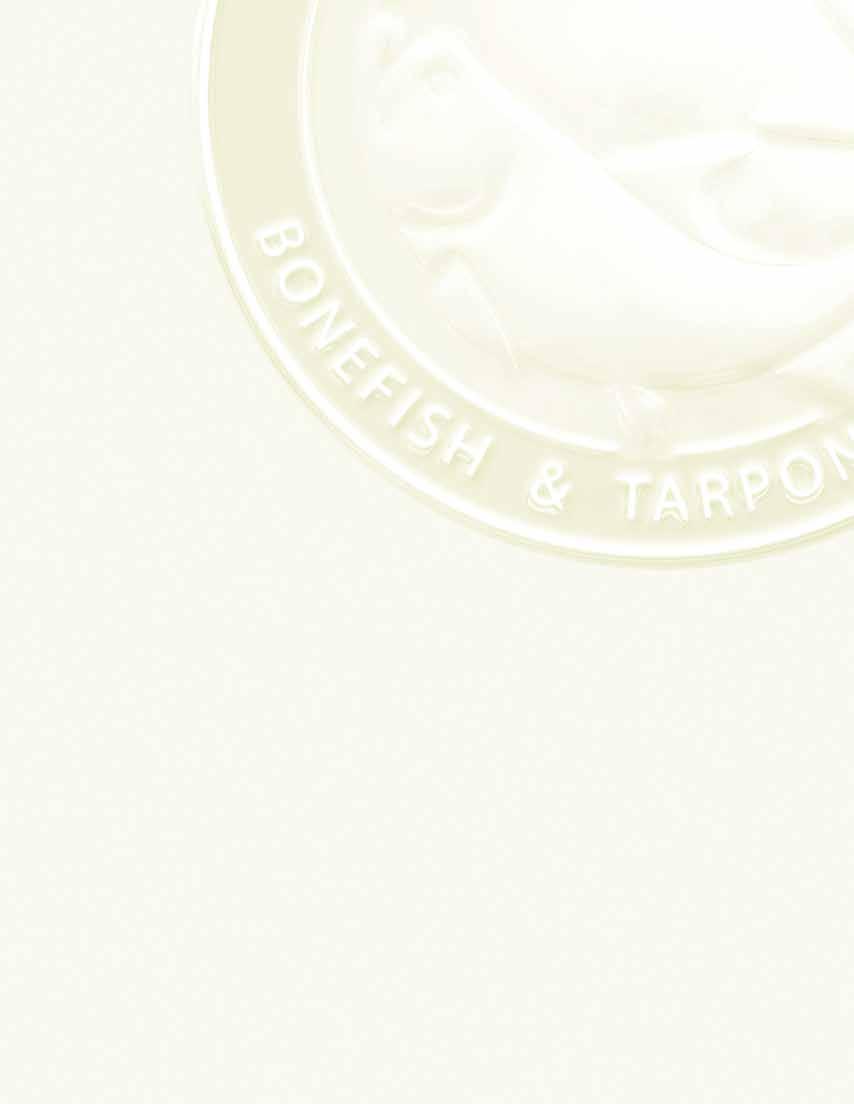

There’s a new flag flying over Bonefish & Tarpon Trust these days. And although it began as a logo to illustrate the international connections in our flats fishery, it has become emblematic of our mission and work today.

Recent studies conducted by Bonefish & Tarpon Trust have demonstrated that the bonefish and tarpon we pursue on our favorite flats are connected in varying degrees to bonefish and tarpon elsewhere across the Caribbean. BTT’s Tarpon Genetics Project, completed in 2017, gave us our first glimpse of this connectivity when it provided scientific evidence of a single, distinct population of Atlantic tarpon—the result of genetic mixing over generations, driven by both migrating adults and the transport of tarpon larvae on ocean currents.
We went deeper in our examination of bonefish connectivity, beginning with an ocean modeling project to better understand how ocean currents might transport bonefish larvae from where they were spawned to more distant waters. It showed that Belize and Mexico likely provide a lot of larvae to the Florida Keys, and even suggests that some larvae from southwest Cuba reach the Keys. The subsequent Bonefish Genetics Project, completed less than a year ago, analyzed more than 11,000 bonefish genetic samples and showed that bonefish throughout the Caribbean share sufficient genetic similarities to consider the region to have a connected population. Moreover, some locations were more closely connected due to geography or a link provided by stronger ocean currents.
The message to us is clear. In order for our conservation efforts to succeed, we must work locally and regionally. We must look over the horizon to understand what is happening in this large, interconnected fishery, and to engage actively in its conservation. If Belize, Mexico and Cuba are indeed significant sources of bonefish larvae for the Florida Keys, then we must advocate for sound, science-based conservation and effective management of those

fisheries. Similarly, we will need to collaborate like never before, which brings us back to the flag. It represents a sort of “United Nations” of flats fishing, depicting the coalition of stakeholders regionally that will be needed to ensure conservation on such a
It should come as no surprise that this larger, international interest is reflected throughout our work at BTT and also in this issue of the Journal. In the pages that follow, you will read about bonefish spawning research in the Bahamas and a new study assessing the economic impact of Bahamian flats fishing. You’ll also read about the remarkable Sian Ka’an in Mexico—a region where BTT is expanding its efforts with a new strategic plan encompassing Belize and Mexico—and several updates on our ongoing, multi-faceted work in the Florida Keys, including recently initiated research to understand bonefish disease and the loss of permit to predators.
It’s fitting that we also profile two legendary friends of BTT who will become the first inductees in our new Circle of Honor next January—Stu Apte and the late Billy Pate. Stu has fished the Caribbean and around the world, including Cuba just last year. He’s no stranger to the connections found across our fisheries. And Billy is still remembered today for first posing the question about tarpon connectivity many years ago, “Are our fish their fish?” Billy was concerned about whether the harvest of tarpon in South America had an impact on Florida’s fisheries, including observed declines in some of his favorite fishing spots. Those words became part of the collective inspiration—and concern—that led to BTT’s research and ongoing conservation actions benefitting the species.
We thank you for your support and advocacy of science-based conservation of our shared flats fishery—in US waters and beyond!

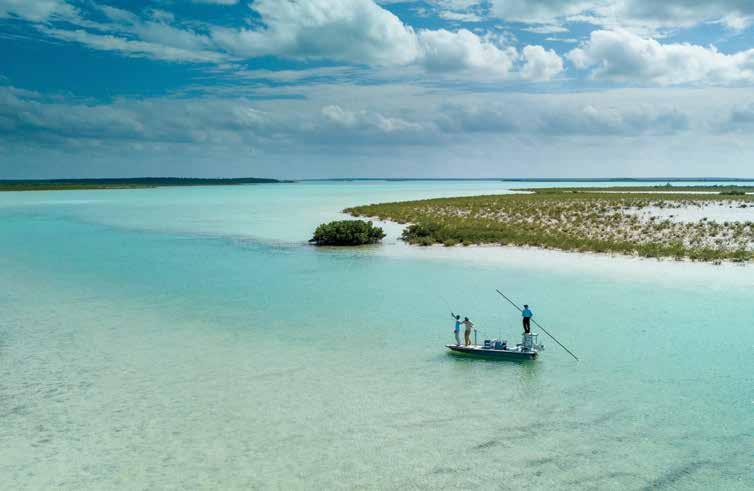
Often when we are on the flats chasing bonefish, tarpon, or permit, we focus on the small things. Things like how tides influence bonefish movement on a flat, or tarpon movements along a beach. We need this focus to give ourselves the best chance at finding and landing fish.
In the science and conservation world, we also focus on specific issues. This could be determining whether pharmaceuticals are in bonefish, and, if they are, what are the impacts? Or identifying permit spawning sites or juvenile tarpon habitats. These specifics are essential to making sure we push for the best conservation plans.
But part of our job at BTT is to put all of these smaller components into the context of the bigger picture. So even as we focus on bonefish movements with the tides on their home flats, we also work to track their spawning migrations and figure out where they spawn. Other recent examples of this bigger picture perspective include: the findings of bonefish regional connectivity by larval transport, which shows that we can’t just think locally about bonefish conservation and restoration; and permit movements between the flats and reefs/ wrecks, and how fishing on the wrecks might be impacting the flats fishery.
But in addition to the bigger picture, we also have to focus on the fundamentals. This is why we are increasing our efforts to advocate for the inclusion of habitat in fisheries management.
The science of fisheries stock assessment originated to address overfishing by commercial fisheries. The mathematical models were developed to use the data available—the sizes, ages, and numbers of fish harvested—to estimate fish population size, the age structure of the fish population, and then the number of fish that could be harvested and still sustain a fishery in the long term. This poses two problems for bonefish, tarpon, and permit.
First, this approach relies on some level of harvest to provide the necessary data. Since bonefish, tarpon, and permit are entirely or mostly catch and release, these harvest data aren’t available. This is why there has never been, and likely never will be, a stock assessment for bonefish, tarpon, or permit. We need a different approach for these types of fisheries.


Second, the traditional stock assessment approach doesn’t include habitat data. As we suffer increasing loss and degradation of habitats, this is becoming more of a problem. Since we know that the amount of habitat is a large controller of fish population size, we can surmise the impacts of habitat loss on fish populations. This is especially concerning for coastal fish because this is where most of the habitat loss and degradation occurs, and for nursery habitats, since juveniles are typically the most vulnerable.
So even as we focus on topics as varied as regional connectivity of bonefish, to permit movements in the Keys, to tarpon migrations, underlying all of this is the fundamental issue of habitats. The fisheries can only be as healthy as the habitats, and the habitats have to be abundant to support large fish populations.
Our goal with the Habitat is the Future of Fisheries campaign, featured in this issue, is to work with FWC to create new ways to focus on habitat and to incorporate habitat information into management plans. This is a focus on the fundamentals with an eye on the big picture.
The next time you go fishing, think about where you are fishing from a fish’s perspective. Are the habitats expansive and healthy, giving the fish plenty of space to find prey and avoid being eaten, to migrate to spawn, to survive as juveniles? Then make your voice heard and advocate for habitats.

 Photo: Scott Morrison
Photo: Dr. Aaron Adams
Photo: Scott Morrison
Photo: Dr. Aaron Adams

Bonefish & Tarpon Trust recently welcomed three new leaders to its Board of Directors and Advisory Council—each distinguished in their professional endeavors and commitment to the conservation of bonefish, tarpon, and permit.
Veteran Key West guide Captain Doug Kilpatrick has joined BTT’s Board of Directors. His accomplishments include guiding to 23 IGFA World Records and numerous tournament wins. Kilpatrick also serves as president of the Lower Keys Guides Association, a nonprofit organization of professional fishing guides dedicated to working for a sustainable resource through wise management practices, while recognizing the importance of sportfishing to the economy and cultural heritage of the Florida Keys.

Through his leadership, Kilpatrick has solidified partnerships between BTT and LKGA as the organizations work together to improve the permit fishery. He has backed conservation initiatives to protect the flats fishery, including extending the closed harvest season for permit in the Special Permit Zone. He also supported the extension of the Research Natural Area designation for the Dry Tortugas, where a large permit spawning aggregation exists that provides larvae to the Florida Keys.
“I am honored to serve on the board of Bonefish & Tarpon Trust,” said Kilpatrick. “As a fishing guide of 25 years, I have been fortunate to be able to spend my career with great people in beautiful places. I am excited
to give back to something that has given me the greatest years of my life. As a board member, I will help work to preserve and improve the fishery that we all have come to cherish.”
Joining BTT’s Advisory Council are Captain Paul Dixon and Christopher Jordan. Recognized as one of the early pioneers in sight-fishing for striped bass in the Northeast, Dixon began fly-fishing in 1971 in Idaho, where he took a summer job guiding. In the early ‘80s, he moved to the East Coast, spending five years working at Orvis in New York City. He went on to open his own store, Dixon’s Sporting Life, in East Hampton on Long Island. Dixon now divides his time guiding between Montauk and the Florida Keys. He has been involved with BTT for more than two decades, during which time he helped to launch and develop the organization’s very successful annual event in New York City.
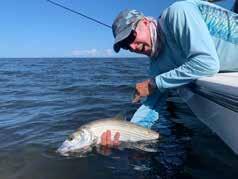
“I remember going to the first meetings for Bonefish & Tarpon Trust over 20 years ago,” said Dixon. “I was totally sold on the idea that through science and research we could better understand and protect these great fish we pursue, and the habitat they need to
exist. Great strides have been achieved by BTT with much work still to do. I’m honored to be appointed to its Advisory Council and look forward to continuing our worthy mission.”
An Executive Vice President within Wells Fargo’s Commercial Real Estate Group, Christopher Jordan is a member of the company’s Management Committee and oversees Specialty Real Estate Finance.
“Having experienced my most memorable angling moments chasing bonefish, permit and tarpon with a fly rod, I am extremely
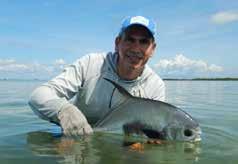
passionate about these remarkable game fish,” said Jordan. “BTT’s scientific research, conservation projects, and advocacy for healthier habitats are critically important to the future of these species and the environments they inhabit. I’m very grateful for the opportunity to join the Advisory Board and to help advance BTT’s mission.”
Jordan has fly-fished throughout the United States and internationally for three decades. He and his wife and son live in McLean, Virginia, but spend significant time each year in Islamorada, where they have owned a home since 2012.
“The leadership of our Board of Directors and Advisory Council has played a defining role in BTT’s growth and success over the past two decades,” said Jim McDuffie, BTT President and CEO. “We’re fortunate to have Doug, Paul, and Chris continue their valuable service to the organization in these leadership roles. Their experience and dedication to the health of the flats fishery will help ensure our future success.”


Please mark your calendar and make plans to attend the Bonefish & Tarpon Trust 7th International Science Symposium and Saltwater Flats Expo on November 13 - 14, 2020, at the Bonaventure Resort & Spa in Weston, Florida. The theme of the Symposium will be Conservation Connections. Stay tuned to BTT.org for details.
Maverick Boat Group has renewed its signature sponsorship of Bonefish & Tarpon Trust’s Tarpon Acoustic Tagging Project, designed to broaden our understanding of tarpon movement and habitat uses. The results will help shape future conservation measures, including the protection of critical habitats and improvements to fishing regulations. The five-year project, now in year three, uses acoustic telemetry to identify tarpon movement patterns and important habitats. It utilizes an extensive collaborative network consisting of thousands of acoustic receivers stretching across the Gulf of Mexico and along the coastline of the Southeastern US. To date, the project has tagged more than 150 tarpon and collected more than 70,000 detections.

A tarpon tagged in Southwest Florida. Photo: Ed Glorioso
tagged by Markk, who has been a leader in advocating for the conservation of bonefish and their habitat in Long Island. Justin also had the opportunity to present to three local schools: Simms Primary, Glinton’s Primary, and NGM Major High School. All three participate in the Bahamas National Trust (BNT) Discovery Club Program, which includes the flats ecosystem curriculum jointly developed by BNT and BTT. Justin spoke at length to the students and teachers about bonefish biology, flats ecology, and the importance of conservation. While presenting to students at NGM Major High School, he learned that the geography class was completing a project on the flats environment and had recently taken a field trip to visit the local flats, where one of the students landed a tagged bonefish on fly. The fish was recaptured in the same area where it was tagged by Markk and Justin only a few months earlier, underscoring the fact that bonefish have small home ranges. This recapture by a student angler is a great example of the intersection between BTT’s research and education efforts. In the coming months, Justin will return to Long Island to give more school presentations and lead students and teachers on field trips to the flats. We thank BTT Conservation Captain Markk Cartwright and Nevin Knowles for helping facilitate the trip and all of the teachers who gave their students the opportunity to learn more about the flats ecosystem and the importance of the Bahamas’ bonefish fishery.
The winner of BTT’s annual members-only drawing and his/her guest will enjoy four nights at Grand Bahama’s East End Lodge and three days of guided fly-fishing with the lodge’s team of veteran guides. The East End of beautiful Grand Bahama Island boasts some of the most productive bonefish flats in the entire world. There are five, large channels that run northeast to southwest on the island’s eastern horn, providing ample wind protection and allowing anglers to fish the best tides throughout the day. A scenic forty-minute drive from Freeport, East End Lodge features well-appointed accommodations, delicious Bahamian fare, and an expert guide staff committed to making your trip one you will never forget. All dues-paying members who join or renew during 2019 will be automatically entered to win, with the drawing taking place on January 6, 2020.
Costa Del Mar has renewed its Platinum Sponsorship of Project Permit, a nearly 10-year project that is improving permit conservation in Florida. Project Permit began in 2010 as a darttagging program. The initial goal was to get a handle on overall permit movements in Florida, to answer the question: Are the permit in the Florida Keys the same fish that anglers fish for in other parts of the state? Project Permit has since expanded to include acoustic telemetry to obtain more specific data on permit movements and habitat use. Data from Project Permit were instrumental in Florida Fish and Wildlife Conservation Commission’s creation of the Special Permit Zone and the expansion of the SPZ’s permit spawning season closure to include the month of April. To date, more than 1,000 permit have been tagged with dart tags, and more than 140 permit have been tagged with acoustic transmitters. The acoustic
tracking portion of the study, originally designed as a three-year study but extended to five years, is now in its final year of tagging. Efforts in 2019 have focused on the Upper Keys, with the aim of determining the extent to which permit migrate north of the Keys to areas where the species is not as well protected. Project Permit will also continue to examine the permit spawning movements between the flats and offshore wrecks and reefs.

The 14th Annual Trippe’s Tarpon Tournament (The 3T), held April 24 - 26, was once again a success, raising $7,000 in support of BTT’s Tarpon Acoustic Tagging Project. Over the years, the tournament has become increasingly focused on conservation and sustainability. Its unique scoring system rewards good catch and release practices; for example,
anglers can score enough points to win the tournament by jumping fish (each jump is awarded points) retaining their fly, without ever landing the fish. Penalties apply for fights that last too long or losing a tarpon to a predator. “Early on, it was about bringing big fish to the boat and the scoring and activity reflected that,” said tournament founder and BTT member Steve Trippe. “We had an angler, Harvey Mueller, during the second year land a tarpon that measured 87 and 1/8 inches long with a 42-inch girth (230 pounds). I witnessed that catch and it is still the largest tarpon I have ever seen brought to the boat and released. Today, it’s about finding the fish, feeding the fish, jumping them a few times and letting them go after a very short fight, and our scoring has been adjusted to reward and reflect that. Or to put it another way, it’s about respecting the fish and the fishery more.”
This summer, BTT partnered with SweetWater Brewing Company and Costa Sunglasses to Save Our Water and #KickPlastic! A portion of the proceeds from “Kick Plastic Pilsner,” named for Costa’s initiative to reduce pollution in our oceans, will benefit BTT and SweetWater’s other conservation partners. This collaboration was part of SweetWater’s annual Save Our Water campaign, which has donated over $1 million to organizations that protect natural resources and habitats. Over the summer, BTT, SweetWater, and Costa hosted beach cleanups throughout Florida.
In May, 12 members of the Key Largo women’s angling club, The Bonefish Bonnies, spent a week in Cuba aboard the Avalon II mothership and fly-fished in Jardines de la Reina (Gardens of the Queen). Visit BTT.org/blog to read BTT board member Sarah Cart’s account of the memorable expedition.
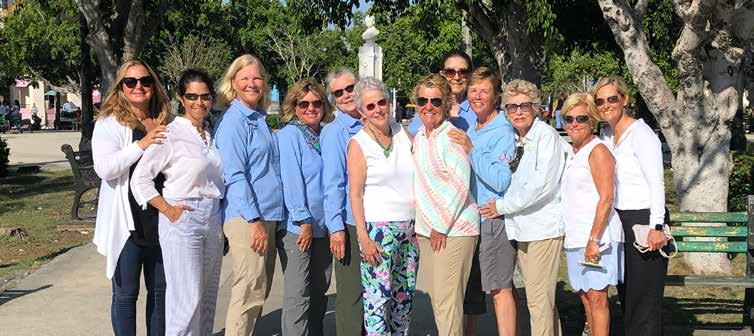




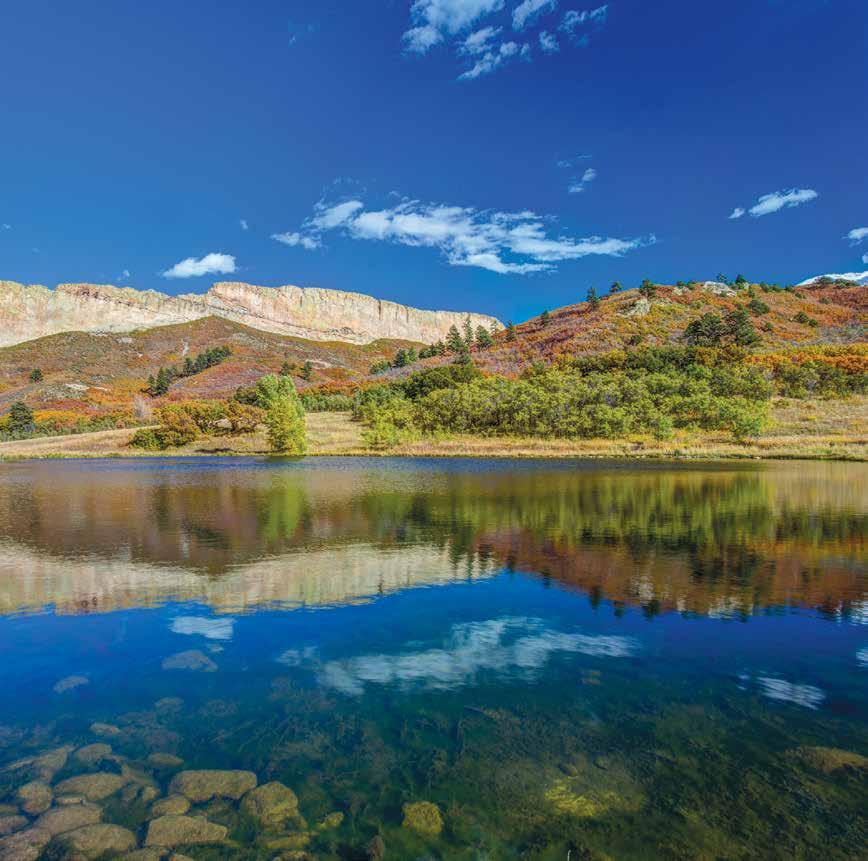




Florida’s recreational and commercial fisheries generate more than $27 billion annually for the state’s economy. These fisheries rely on healthy habitats. As our coastal habitats continue to decline, so too will our fisheries:
• Florida Bay has lost 1/3 of its seagrass.
• Freshwater discharges from Lake Okeechobee into the Caloosahatchee and St. Lucie rivers are killing seagrass and oysters, and causing fish kills.
• More than 44% of Florida’s wetlands have been lost.
• Tampa Bay has lost nearly 50% of its mangrove forests.
• Charlotte Harbor has lost nearly 60% of its mangrove habitat.
• The number of Keys flats classified as “severely degraded” due to propeller scarring has increased by 90% over the last 20 years.
Florida’s fisheries are currently managed using bag limits, slot sizes and seasonal closures, but we are still seeing a downward trend of many recreationally harvested and catch-andrelease only species. The reason is the major decline in habitat (both quantity and quality) in Florida. The state has lost a vast amount of coastal habitat to development, altered water flows, and pollution from nutrient runoff and contaminants entering the watershed. The only way to protect and improve our fisheries is through habitat conservation and restoration. To do this, we must include Habitat in Fisheries Management Plans. And we need your help!
We urge anglers, guides, fishing and boating companies, and other stakeholders to sign the Habitat is the Future of Florida Fisheries petition at: btt.org/habitat/petition
By signing the petition, you are expressing your support for the collaboration between Florida Fish and Wildlife Conservation Commission (FWC) and Bonefish & Tarpon Trust to create a new way to manage our fisheries that focuses on habitat. This includes habitat identification, habitat protection, habitat restoration, and incorporating habitat into fisheries management plans.
These declines will continue unless habitats are protected and restored.
The amount of appropriate habitat determines the population size for each species. In other words, as habitats are lost, the ability of the ecosystem to support healthy fish populations declines.
Of special concern are nursery habitats that support juvenile fish. For many fish species, the amount of healthy nursery habitat determines the adult population size. These critical habitats are often in areas impacted by human development, making them especially vulnerable to degradation.
Unlike adults, juvenile fish can’t move to other habitats if their nursery habitats are degraded or destroyed. It takes years for juveniles to grow large enough to become adults in the fishery. This means that many of the declines in fish populations that we are witnessing today are a direct result of the habitat loss Florida has suffered in the past.
The traditional mode of fisheries management is based on fishing effort

and harvest—this includes fish that are kept and fish that die after being released. The problem is that this approach is no longer adequate.
No amount of regulation can prevent further decline to the flats fishery unless we begin incorporating habitat into fisheries management plans. Steps must be taken to identify and assess critical habitats, to protect those that are intact, to restore those that are degraded, and to effectively manage them all. If we fail, fish populations will continue to decline regardless of the regulations created to safeguard them.

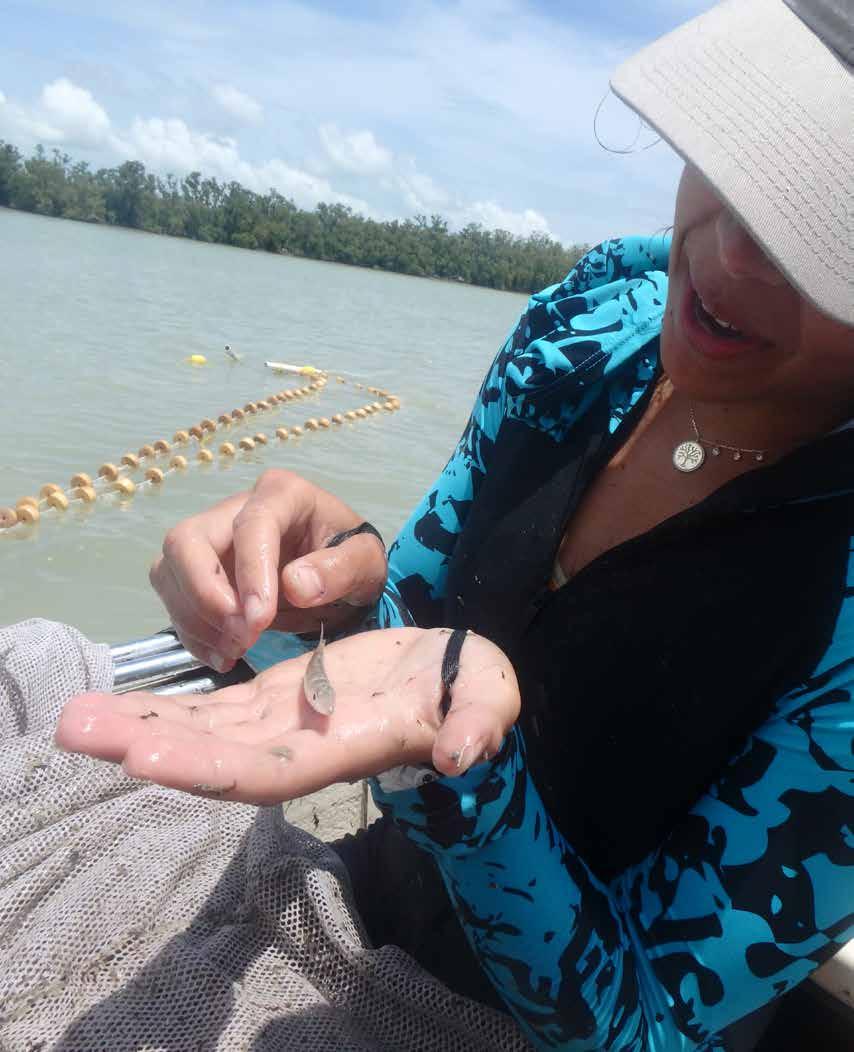
ROSS BOUCEK, PH.D.
Florida Keys Initiative Manager, Bonefish & Tarpon Trust
STEVEN M. LOMBARDO
Florida Atlantic University, Harbor Branch Oceanographic Institute
ROLANDO O. SANTOS, PH.D.
Postdoctoral Research Associate, Institute of Water and Environment - Florida International University
he Florida Keys bonefish fishery is not what it used to be. Though there is a resurgence of small bonefish, the fishery is but a shadow of its former self. To restore it to the way it was 20 to 30 years ago necessitates science-based habitat protection and restoration in the Florida Keys and other places in the Caribbean with which it is biologically connected. We must protect healthy and restore degraded juvenile habitats, adult habitats, spawning sites, and the habitats that support populations of bonefish that provide us with larvae from other locations in the Caribbean.
Over the last 10 years we have launched multiple research initiatives to explore biological connectivity and identify critical habitats that support our fishery. With the help of Florida Keys guides, we mapped flats that currently and historically supported adult bonefish. This information will help guide restoration of the bonefish population by allowing us to focus on the habitats that are key to understanding the likely causes of the bonefish population decline. We can also monitor these habitats as a way to gauge recovery; if bonefish begin to repopulate the places they used to live, and the fishery also expands to these areas, that would be a good indication that a true recovery is under way.
We have also moved forward with protecting and restoring biological connectivity. Our recently completed studies on bonefish genetics and ocean current transport of bonefish larvae revealed that larvae from bonefish spawning in Cuba, Belize and Mexico end up in the Florida Keys. In other words, some of the bonefish that we catch in the Keys were spawned in the Caribbean. To protect those fish and the habitats that support them, we launched our Belize Initiative to protect important bonefish habitats there, and we are working hard to develop a similar initiative in Mexico.
This new information has helped us focus on two important questions that we must address to develop a restoration plan for bonefish in the Keys. First, where are the habitats that support juvenile (less than three inches) bonefish? Second, where are the spawning sites for our Keys bonefish?
We are using two approaches to find juvenile bonefish: pulling seine nets and placing baited underwater cameras in areas we suspect may be home to baby bonefishes. In 2019, we conducted 85 seine hauls and deployed 61 baited cameras from Key West all the way to Biscayne Bay. Despite all of this effort, the only place we have found baby bonefish is in Garfield Bight, the epicenter for the Florida Bay seagrass die-off. Garfield Bight is brackish water in the wet season and, due to the lack of freshwater flow to Florida Bay, too salty in the dry season.
To determine where adult bonefish lived as juveniles, we are analyzing the chemistry of their ear bones, called otoliths. As bonefish grow, they continue to add new bone material on the otolith, similar to how a tree lays down growth rings. As bonefish go through their daily lives, their ear bone absorbs natural chemicals from the surrounding water that leaves a distinct chemical imprint of the environment in which they were living at the time. And since each layer on the otolith corresponds to a time in the life of the bonefish, we can calculate when the fish was a juvenile and use the chemical composition of the otolith layer to determine its possible habitat. To do this, we drill into the otolith, take samples from the different layers, and analyze the chemical composition. We then compare this composition to the chemistry of different habitats in the Keys to estimate where the juvenile might have lived.
So far, many samples are in agreement with field collections of juveniles in Garfield Bight. This is because chemicals in the juvenile layers of bonefish otoliths suggest that many bonefish in the Keys reside in more brackish water areas as babies, particularly for adult

bonefish that were collected in places like Biscayne Bay and around Islamorada. These two lines of evidence tell us that some portion of our baby bonefish live in places that are directly influenced by freshwater management. This discovery means that our bonefish fishery is more connected to how we manage fresh water than we thought.
We also need to find where the Florida Keys bonefish spawn for two reasons. First, we need to protect these special areas to ensure our bonefish can reproduce undisturbed and safely. Second, we need to determine the portion of the Florida Keys bonefish population that was spawned locally versus spawned in the Caribbean. This will tell us the extent to which we need to focus on local and regional management.
To find these spawning sites we are using multiple scientific methods. First, we are tracking bonefish movements and migrations. From our Bahamas research, we know that bonefish generally stay within a twomile home range area as they go about their daily lives. But when they reproduce, they can migrate long distances to reach their spawning sites. We see evidence of these long-distance spawning migrations in the Keys. On several occasions, bonefish that were externally darttagged in Biscayne Bay and in Key Largo were recaptured in Key West, over 80 miles away. The recaptures occurred during winter, which is bonefish spawning season. With the expectation that bonefish in the Keys make long distance spawning migrations, we are tracking bonefish by tagging them with acoustic tags (the same technology that we use for Project Permit and the Tarpon Acoustic Tagging Project), which will allow us to track their migrations. We will follow these tagged bonefish through the spawning season of 2019, and hope they lead us to their spawning sites.
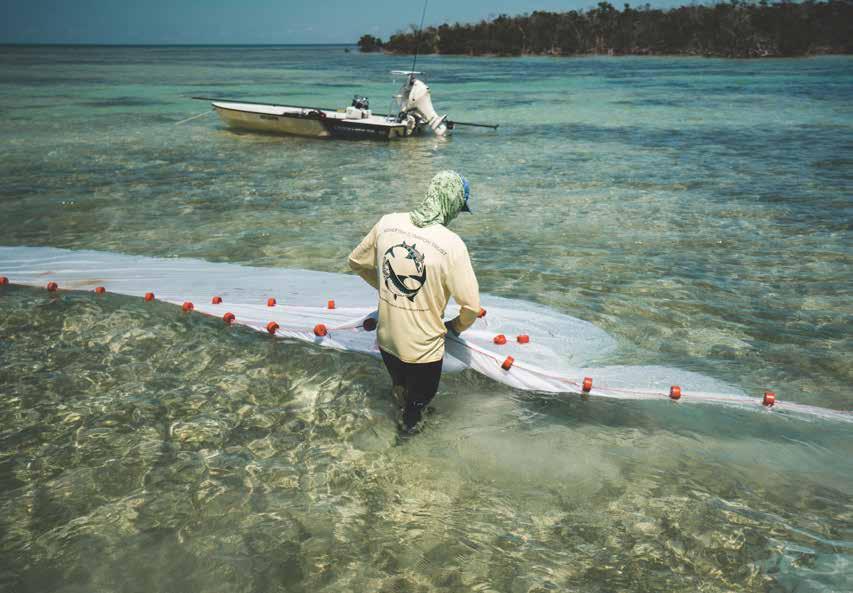
We are also relying on anglers and guides to report bonefish that are showing pre-spawning behaviors. From our research in the Bahamas, we know that at sunset when bonefish are about to spawn, they form large pre-spawning aggregations of sometimes over 10,000 fish. These fish porpoise, gulp air and make a noticeable commotion at the surface of the water. Also, if a bonefish is caught right before it spawns, the fish will sometimes release milt or eggs, indicating that a spawning site may be close by.
Based on information obtained by working with anglers and guides, there seem to be two areas where bonefish spawning aggregations are likely to occur, one in the Middle Keys and one in the Lower Keys. During the 2019 spawning season, we will have research teams on the water in these areas searching for signs of these spawning aggregations so that we can confirm their locations and advocate for special protections for these sites
Finding the causes for why bonefish populations have declined has been a complex and multi-faceted process, and developing the solutions needed to restore the fishery will be as well. Our research is getting us closer to a restoration plan every year. And by working with the Florida Keys National Marine Sanctuary and the Florida Fish and Wildlife Conservation Commission, we will be able to begin putting the habitat pieces back together. Protecting and restoring the habitats that bonefish need in the Keys is critical to bringing our fishery back.
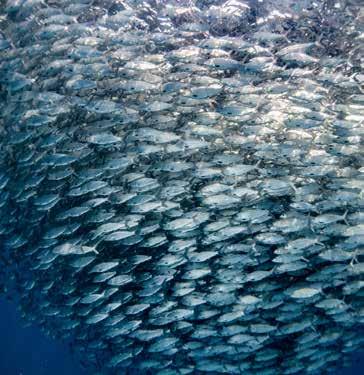




Islid the final piece of the fly rod into the rod sock, dropped the sock into the rod tube, screwed on the cap, and placed the tube next to the pile of gear and clothing on my bed. I took a last survey of the pile and realized my passport was still in the drawer. After adding the passport to the pile, I was satisfied that I was ready to load my bag for my trip to the Bahamas. The weather forecast looked good and the tides were perfect, so anticipated a good trip.
As I was transferring my gear and clothing into my bag, it dawned on me how much money I’d invested in fishing. Rods, reels, fly line, flies, flats boots, technical clothing, sunglasses. These items had been acquired bit by bit, hiding the cost as my money dribbled out over time. But seeing it all there in a pile brought the economics of fishing front and center.
Following this train of thought, I pieced together the cost of my trip to the Bahamas: airfare, taxi, lodging, food, guides, drinks (it’s hard to
resist an ice-cold beer at the end of a day on the flats). Multiply these costs by the thousands of anglers who travel to the Bahamas to fish the flats, and the economic impact of the flats fishery in the Bahamas becomes clear.
The first study of the economic impact of the flats fishery in the Bahamas was completed in 2009. That study showed $70 million in direct expenditures (the money spent by anglers for taxis, guides, lodging, food, etc.). But economists know that this injection of money into the economy spurs additional spending—the people who get paid (such as the guides) have money they are able to spend within the economy—so they calculate the secondary effects of the direct expenditures, which in 2009 brought the total annual economic impact to $141 million.
Given that economic data can become outdated, in 2018 BTT commissioned a second study of the economic impact of the flats
fishery in the Bahamas. This study was just completed. The total annual economic impact of the flats fishery in the Bahamas has grown to $169 million. This economic impact is especially important in the Family Islands away from Nassau and Freeport. For example, when the impacts of all tourism for the Bahamas are considered, the flats fishery accounts for 7 percent of tourist expenditures. But when only the Family Islands are considered, the flats fishery accounts for 13 percent of tourism expenditures.
The importance of the flats fishery is even more evident when examined by island. For example, the flats fishery was responsible for 80 percent of tourism expenditures on Andros.
Additional results from the study are also revealing. During 2018, an estimated 23,400 anglers were guided on the Bahamian flats by over 250 lodge and independent guides. Another 7,900 anglers used their own initiative to find accessible flats to pursue bonefish.
This activity supported the equivalent of 7,800 full time jobs from direct expenditures (this doesn’t include the jobs that benefit from the secondary effects of increased spending by Bahamians employed in the flats fishery).
Flats fishing in the Bahamas offers a variety of experiences for anglers. The most visible and heavily marketed is the inclusive fishing lodge alternative. Other anglers, however, seek a more “doit-yourself” approach by booking their own lodging and guides and using local food service options to meet their needs. This alternative requires that adequate lodging facilities and food service (grocery stores and restaurants) are near fishing opportunities. It also requires a minimum number of guides and a sustainable flow of visitors to ensure long-term business success. Clearly, business development plans throughout the Out Islands need to tie all aspects of the tourism visitor base together to ensure sustainability guided and unguided fishing opportunities.
The unguided recreational fishery in the Bahamas also plays an important role in many small island economies. These anglers directly support the small independent businesses that provide lodging, food, transportation and other services throughout the islands. Unguided anglers often spend a few days fishing and additional time sightseeing or engaging in other nature-related activities, further extending the tourism benefits on the island. While these anglers may occasionally use guides during their visits, unguided anglers are generally restricted to a few flats that have shoreline access near their lodging. While this may be viewed as competition by some guide businesses, unguided fishing does play a significant role in many island economies and should be recognized for doing so, particularly where few, if any, guides are available.
The future of the positive economic impact of the flats fishery for the Bahamas depends on strong conservation. Based on the survey of fishing guides and lodge managers, habitat loss and degradation are concerns. For example, mangrove destruction, soil erosion and channelization all were noted by guides and lodge managers as growing concerns. Further concerns range from the impacts on water quality from waste disposal and runoff to fisheries habitat destruction from development. On this latter point, several examples were pointed to where resort construction cleared dozens of acres of mangrove forest and filled some wetlands areas before the venture closed, leaving the area partially or fully denuded and erosion problems for others to contend with. The promise of these large developments quickly turned to environmental and social concerns for residents.
The economic study also used data from the Bahamas Ministry of Tourism, which conducts surveys at the major airports of Nassau and Freeport. These surveys found that more than 90 percent of anglers stated that they would not travel to the Bahamas if they were unable to fish. This underscores the importance of maintaining healthy habitats and fisheries as the only way to sustain the economic impact of the fishery.
The Bahamas competes with other Caribbean and Central American countries for flats fishing anglers from the United States and around the world. These other countries are beginning to recognize the economic benefits of flats fishing and the low impact it has on local fisheries resources. As a result, these countries are giving increased attention to marketing their fishing opportunities by focusing on aspects of flats fishing experiences unique to their countries. In Belize, for example, the government passed catch-and-release-only protection for bonefish, permit and tarpon. The fishing industry there is actively using this new legislation to underscore the country’s commitment to conservation and the protection of these valuable species. Further, if/when relations between the U.S. and Cuba are normalized, an additional destination for American anglers will be added to the mix of flats fishing opportunities in the region. Thus, the Bahamas has a very strong incentive to protect the habitats that support the flats fishery to remain competitive.
To remain competitive in this very discriminating and competitive market, the Bahamas will need to ensure that the quality of the

flats fishing opportunities available remain competitive with those in other countries. This means that the perceived value of flats fishing in the Bahamas is at least equal to or exceeds those of other countries. The flats fishing industry in the Bahamas should begin identifying the unique qualities of their fishery and determining which of these characteristics differentiate the Bahamas from other fishing destinations. This would allow guides, fishing lodge owners, resorts and government to use these unique characteristics to strengthen the bonefishing brand in the Bahamas and ensure that the economic benefits continue to grow.
An important tool that the Bahamas government has in its toolbox to ensure a sustainable and economically valuable flats fishery is habitat conservation. Recent and ongoing research shows that bonefish have small home ranges, migrate long distances to spawn, gather in pre-spawning aggregations in nearshore areas away from the flats, and spawn at night in offshore waters. Habitat conservation that ensures healthy habitats for home ranges, spawning migration pathways, pre-spawning sites, and offshore spawning is an investment in this economically valuable fishery by the Bahamas government. Indeed, the economic value of the flats fishery can be sustained in perpetuity with proper investment in habitat conservation.



face. From research in the mid-1990s, we know permit migrate off the flats to deeper waters, where they aggregate in the hundreds to thousands in the spring and summer to spawn on reefs and wrecks. At the aggregations, catch rates are high, with anglers often catching 10 to 15 permit a day. In the Florida Keys, even though permit are protected from harvest during their spawning season, a popular offshore catch and release fishery exists for the species. Angler reports suggest that a high percentage of permit that are hooked at their spawning sites are eaten by predators (mostly sharks) before they are brought to the boat.
FLORIDA KEYS INITIATIVE MANAGER, BONEFISH & TARPON TRUST
JACOB BROWNSCOMBE, PH.D
BANTING POSTDOCTORAL FELLOW, DALHOUSIE UNIVERSITY RESEARCH ASSOCIATE, CARLETON UNIVERSITY
BENJAMIN M. BINDER
GRADUATE RESEARCH ASSISTANT, MARINE ECOLOGY & ACOUSTICS LABORATORY, FLORIDA INTERNATIONAL UNIVERSITY
Allowing fish to spawn successfully is one of the most important ways we can ensure a fishery will be sustainable. On the flip-side, the fishing of spawning aggregations can cause a fishery to crash in a very short amount of time. The sharp decline in the population of Nassau grouper in the Caribbean is a sobering example of the adverse consequences of intense aggregation fishing. As fishing of Nassau grouper spawning aggregations became popular, the population dropped so drastically that the fish became an ICUN-listed endangered species. So far, although Nassau grouper spawning aggregations were given
protection from fishing, the populations have been slow to recover. In time, it’s hoped that continued prohibition of fishing the spawning aggregations will restore the grouper populations. Obviously, the best conservation approach is to prevent the problem in the first place. Central to Bonefish & Tarpon Trust’s conservation mission is finding where permit, bonefish and tarpon spawn, so we can protect the spawning fish and the habitats they use.
A permit spawning aggregation. Photo: Dr. Jiangang Luo
Important goals of Costa’s Project Permit are to identify spawning sites for permit in the Keys and assess the threats those fish may
To identify where permit are spawning, we are using acoustic tracking. We implant into permit transmitters that send a unique sound pulse that can be detected by hundreds of specialized sensors spread throughout the Keys. This technology provides scientists with detailed day-to-day movements of permit on the flats and offshore on the reef tract. To date, we have tagged over 140 fish and followed them to their spawning sites. From our tracking work, we discovered that there are quite a few places where the flats fish spawn. However, one place, known as Western Dry Rocks, is an especially important spawning site because so many flats permit go there to spawn. More fish migrated off the flats to spawn at Western Dry Rocks than any other place we found. As such, fishing at Western Dry Rocks, if there are sharks around, could have a significant impact on the permit fishery.
We think that permit spawn at Western Dry Rocks because of the ocean currents that carry the larvae after the adults spawn. At Western Dry Rocks, irregular ocean currents exist called the Pourtales Gyre. This gyre keeps larvae out of the Gulf Stream and instead circulates them back into the Keys. So, the permit that spawn at Western Dry Rocks have a better chance of their larvae staying in the Keys, and the resulting juveniles growing up in the Keys, compared to if they spawn in places like Marathon or Key Largo.
The second phase of this research is to assess the threats permit experience at the Western Dry Rocks aggregation. Over the last two years, with the help of expert light-tackle captains, our scientists fished Western Dry Rocks for permit. With various underwater cameras and other equipment, they determined that, on average, 39 percent of hooked permit were eaten by sharks before they could be landed. These numbers raised warning flags, as mortality rates
of 20 percent for other fish similar to permit can trigger significant population declines. Research continues to refine the permit mortality rates and the impacts, if any, of the offshore angling.
In summary, protecting spawning fish is essential to ensuring a productive fishery in the future. Unlike grouper and snapper that are harvested at their spawning aggregation sites, permit are lost due to predation in a catch and release fishery; but whether harvested or eaten by a shark, the fish is lost from the population. Reducing mortality within a catch and release fishery may necessitate new management approaches, which are needed to conserve the fishery. We expect the data from this research project to be applied to the ongoing Florida Keys National Marine Sanctuary management plan revision process.
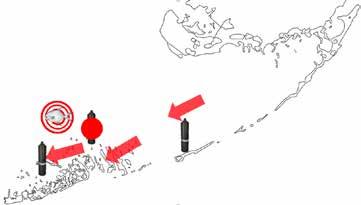

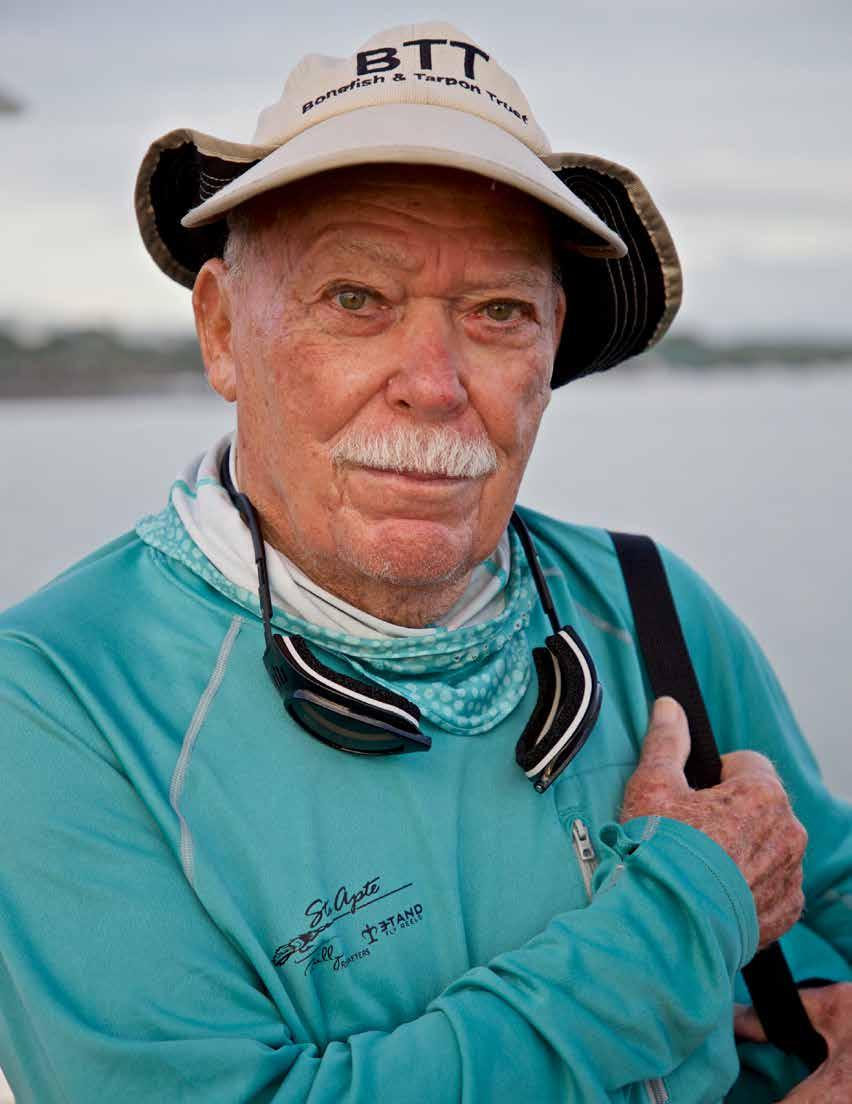
and minutes later were pulling grunts and mangrove snappers from the bay, using handlines of cotton string, wrapped around sticks, their scrounged pieces of fish bait sunk to the bottom with scrounged nuts and bolts.
It took pluck, and gumption, and luck to make it to the water back in those days. But that was Stu Apte’s modus operandi then, and it remained his MO for the next eight decades: Get to the fish, whatever it takes.
Apte’s has been a journey of nearly unfathomable adventure, of travel and danger and pioneering forays to the edge and even beyond the frontiers of what was considered possible with a fly rod. He has guided anglers as famous as Ted Williams and General Norman Schwarzkopf, and has hooked, fought, and landed fish on every continent but Antarctica. Over his 89 years, he has held some 45 saltwater light tackle and fly rod world records. Two still remain as the longest-standing saltwater fly rod records on the IGFA books: a 58-pound dolphin landed in 1964 and a 136-pound Pacific sailfish caught the next year. Both were brought to heel on 12-pound tippet.
He seems to have lived multiple lives in a single lifetime. As a U.S. Navy fighter pilot, he crash-landed an SNJ trainer plane in a cornfield. On a training run along the North Carolina coast his F5F-9 Panther Jet caught fire at 20,000 feet. He ejected moments before the plane exploded. Apte went to work for Pan American Airways in 1957, and was given the option of short passenger hauls to the Caribbean or long-haul freight runs. He chose the latter, knowing he’d have more time off to fish between flights.
etting to the fish was always the first hurdle.
In the years to come, decades down the road, he could walk into practically any airport in the world, grab a jump seat in the cockpit of a commercial airliner and get to the fish—fish in New Zealand, in Africa, in Australia, in parts of the world that traveling anglers had yet to even consider. Most of the time, he’d be moved from the jump seat to a first-class berth before the plane climbed 10,000 feet. That was a perk of being a former U.S. Navy fighter pilot and 34-year career pilot with Pan American Airways: Getting to the fish.
But that was in the years to come. At the time, the five-year-old Stu Apte was hunched over on the corner of Miami’s SE 1st Street
and Miami Avenue, behind Burdine’s Department Store. He and his brother, Marvin, had already walked from their house and ridden one streetcar. Now they needed to find a pair of discarded one-penny streetcar transfer tickets, so they could hop the trolley to the County Causeway, which arched over Biscayne Bay between Miami and Miami Beach.
When he tells the story, Apte pronounces Miami the way the oldtimers do: Mi-yam-uh. The way everyone called it back in 1936, when little boys rode streetcars to go fishing.
They boys were in luck: A pair of tickets beckoned from the sidewalk. They scooped up the scrip, jumped on the next streetcar headed east,
A year-and-a-half later, Pan Am furloughed Apte in a massive retraction of pilots around the country, and Apte nearly leapt with joy. He took advantage of the clean slate and moved to what he calls a “one room-shack” with a bed, washbasin, and toilet, in a trailer park on Little Torch Key, two-thirds of the way down the Florida Keys chain. The Keys, fly-fishing, outdoor television, and big-game fishing would never be the same.
“I’ve lived life to the hilt, there’s no denying that,” Apte says. At present, he splits time between the Florida Keys and Rocky Mountain trout water, near Bozeman, Montana, although he’s hearing the siren call of skinny saltwater and shadows ghosting the flats bidding him home to Islamorada for good. His mentor and friend, Joe Brooks, first convinced him to try his hand at the rainbows, browns, and native cutthroats of Montana, but Apte had little interest. “I told him that if I was going to fly-cast to a fish,” Apte recalls, “it won’t be to some piddling trout.” That was pure Stu Apte, self-assured and somewhat obstinate. Until he cast to Rocky Mountain trout for the first time in 1962. “I put every trout in every pool in a spring creek down,” he laughs, “double-hauling and winging every fly too hard. Joe said, ‘Slow down, take it easy, you don’t understand how to give these fish what they’re looking for.’ And I didn’t. But I went back every year since, except for one. And I figured out what those fish where looking for, you can believe that.”
The Florida flats and the Everglades backcountry were the Tigris and Euphrates of modern saltwater fly-fishing, the birthplace and nurturing grounds of an entirely new way to experience saltwater fishing. Apte orbited with the famous and the soon-to-be-famous. He drank mojitos with Hemingway. On Little Torch Key, when he pulled away from the docks, he knew he was being watched. “Flip Pallot would sneak down there and watch me through binoculars to try to figure out where I was going,” he laughs. One day, Apte received

Bonefish & Tarpon Trust has established a Circle of Honor to recognize legendary anglers and conservation leaders who have made significant contributions to the conservation of our bonefish, tarpon and permit fisheries.
The Circle of Honor will be prominently housed in the Florida Keys History & Discovery Center, located in Islamorada, Florida, and will feature an annually rotating exhibit on those honored as well as educational content about the significance of the flats fishery. Each year, the Circle of Honor Selection Committee will choose a living legend for induction and one or more individuals for posthumous recognition. Past recipients of Bonefish & Tarpon Trust’s Lefty Kreh Award, Curt Gowdy Media Award, and Flats Stewardship Award will also be recognized in a digital archive maintained as part of the exhibit.
Angling legend Stu Apte will be the inaugural inductee into the Circle of Honor at a special dinner and awards ceremony to be held on January 16, 2020, at the Florida Keys History & Discovery Center at the Islander Resort. Also to be honored posthumously that evening will be the great pioneering saltwater fly angler Billy Pate.
“It’s fitting that these two legends are the first in the guide and angler categories to be enshrined in our new Circle of Honor,” said BTT President and CEO Jim McDuffie. “As legends of the sport, they’ve influenced the conservation of our flats fishery and helped build BTT as an effective organization capable of pursuing its mission into the future.”
a letter from a 12-year-old Cuban boy whose mother carried him in her arms as a baby to South Florida. The letter included a rough, disheveled fly as both a gift and a token of peace. The boy asked Apte if he might send back a note with his phone number, so the two could talk about fishing. “I was so taken aback,” Apte recalls, “that called the boy myself.”
Years later, when the young man worked as a porpoise trainer at the Miami Seaquarium, he dreamed of guiding fishing charters, and stayed at Apte’s house while getting his captain’s license. Apte even drove him to downtown Miami and co-signed a loan for the young man’s boat. The boy’s name was Jose Wejebe. (And the loan officer, incredibly, was a full-time banker and part-time guide named Flip Pallot.) “That’s the kind of man Stu Apte is,” Pallot says. “He is a very giving human being.”
In the early 1960s, Apte guided more than 330 days each year. At the beginning, Florida Keys guides charged $55 a day. As he booked up, though, he bumped his rates. At his peak in the late 1960s, he was earning better than $46,000 a year. “Serious money at the time, at least for me,” he says. Serious money and serious exposure. Apte appeared on ABC’s Wide World of Sports in 1963, kicking off a career of nearly innumerable television performances. He was writing for some of the biggest magazines in the outdoor business. It all made the decision to return to commercial flying even more painful. Pan Am called him back to work in late 1964.
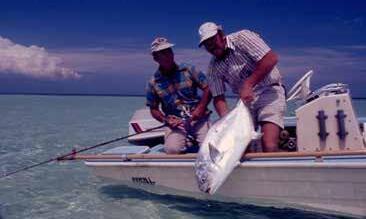
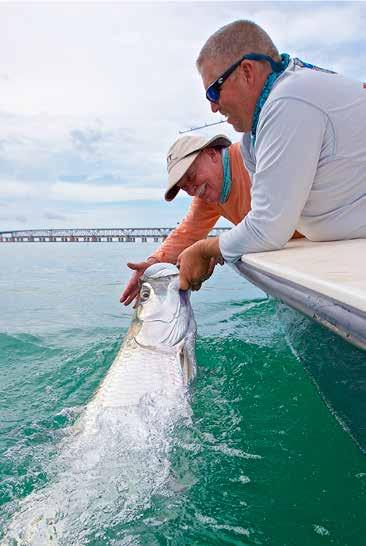

Pallot says, “figuring out what provoked a big fish to feed, and then how to fight them so you’re not pulling on their faces for half the morning. Stu was licking those fish in 12 or 15 minutes when it was taking everybody else two and three hours.” This is the ultimate test of an angler’s skills, not that they can merely stick a fish, but fight it to the boat, fair and hard and quickly, and turn it free while it is still strong and its spirit unvanquished.
On that first year back in the cockpit of a commercial jet, Apte says, he made $7,800. The job carried a financial hit, but flying some of the biggest jets in the world had its perks: It carried him across the globe.
“I was ready for a change,” he recalls, with a nearly defiant edge to his voice. “I wanted to take those eight steps from the poling platform to the front of the boat. I was ready to do the fishing again, not the poling.
“Pan Am was a magic carpet,” Apte says, his voice tinged with a lingering sense of bewilderment at his good fortune. “It took me to the fish. Took me all over the world.”
It’s too easy to linger on the headlines of Stu Apte’s life. And truth be told, he likes to tell those cinematic stories—of the time he traded rum shots with Nicaragua’s President Anastasio Somoza. Of his pioneering 1972 trip to Guyana to land the first arapaima on a fly rod. Stu Apte loves the limelight, and the limelight seems to find him often. But what he loves most is landing enormous fish.
That was one of Apte’s major contributions to the sport of fishing,
The largest fish he ever caught on a fly and brought to the boat measured eight feet long. He landed it on 12-pound test in less than 27 minutes. “People that do this right release a lot of fish in good condition,” Apte says. Part of his approach is a technique he called “down and dirty.” It involves thrusting the rod tip into the water when a big tarpon begins to surface, to make the fish work harder. It’s as much a psychological game as a physical one, Apte says, making a fish fight for every inch of line.
Another Stu Apte lasting legacy has more to do with the future of saltwater angling than with besting whatever trophy fish he has on the line. Apte is a cornerstone of the saltwater fisheries conservation community. “Stu is the center of gravity that draws in and attracts an incredible array of talent in the name of conservation,” says Jeff Harkavy, a BTT founding board member and a devoted friend of Apte’s since they worked together to start a fundraising tournament nearly 25 years ago. “He connects the dots and smoothes the path to so many donors, guides, celebrity anglers, and others in the conservation arena. He will fill a room with friends and fans when the topic is conservation.” But what is even more impressive is how
dedicated Apte is to the unsexy nitty-gritty aspects of conservation advocacy. Despite his fame and travel, Harkavy figures, “he arguably has the best attendance record of anyone who’s served on the BTT board. He absolutely wants to make sure he has a voice in the room.”
And it’s a voice that has never been more treasured. Apte’s experience is so varied, and reaches back so far into the depths of saltwater fishing, that his institutional history allows modern conservationists to see where we’ve been, and where we are, as we work to recover the magic of saltwater fisheries.
“That’s the great value of such a stalwart angler and conservationist,” says Harold Brewer, BTT board chairman. “Stu’s memories of what the Keys were before this modern era serve as a different sort of lens for the rest of us. The starting points we have today are colored by a sense that the fish aren’t as abundant, and that so much has been lost. But Stu brings incredible perspective to this fight. The fact that he is still so excited about the fish and the fishing and these Florida landscapes brings great energy to all of us.”
And the energy is still there, as is the passion for wild waters, whether they flow from snowy peaks or ebb over a sandbar at the bidding of the moon. While he can no longer work a 12-weight on a 12-hour shift, Stu Apte still chases trout in Montana and tarpon in
the Keys. He’s planning an Islamorada tournament to celebrate his upcoming 90th birthday in May. He still designs rods. He still advises boat and tackle companies. He still champions the conservation and restoration of the South Florida wilds where it all began for him.
And when Apte does hook into a significant fish—tarpon or trout, permit or sailfish—he still does it his way. He often clears the line, he says, and gets the fish on the reel, and then reaches into his back pocket for the left-handed cotton garden glove that rides there. He slips it on. “And that’s my drag,” he says, “for the rest of the fight.” He seldom has more than two pounds of drag dialed in to his reels. He wants to feel the fish, feel its power and its panic, cipher its thoughts and strategies through the slender, zinging bond of nylon that disappears somewhere between rod tip and running fish.
“I have the technique down pat,” he says. “I can put 15 pounds of drag on the fish if need to. But if the fish surges, release my fingers.”
He can feel it, right there in his very own fingers—the frantic desire to be free, the destiny of both fish and the people who pursue them. Over his nearly 90 years, that hasn’t changed. Stu Apte can feel it all.
An award-winning author and journalist, T. Edward Nickens is editorat-large of Field & Stream and a contributing editor for Garden & Gun and Audubon magazine.

I’d heard a lot about Billy Pate when I first arrived in Key West in 1971. He was a bit of a legend way back then, but my most vivid memory is the report of his landing a blue marlin on a fly off Cuba in 1978. No one had ever done that before and most thought it to be impossible. It was the sixth species of billfish that Billy had captured on a fly rod. Most people don’t know that Billy set IGFA records for black marlin, white marlin, Atlantic and Pacific sailfish, Atlantic blue marlin and striped marlin before he got that giant tarpon on fly, but tarpon became his passion and tarpon is his legacy.
I finally met Billy in the early ‘80s and we became good friends over the years. In his prime he looked just like Robert Redford. He spoke about tarpon in his lazy southern drawl all the time. Billy was from South Carolina where his family had developed a very successful carpet business, which allowed him to travel and fish as much as he
liked. In the ‘60s Billy discovered the Keys’ tarpon migrations and that they would readily take a well-presented fly. His first tarpon hookup was on a bamboo fly rod which quite understandably exploded. It didn’t take long for him to buy a house in Islamorada. In 1968 he founded World Wide Sportsman, a combination tackle shop and travel agency, with his friend and guide, George Hommell. Billy loved to travel as long as the destination had a serious supply of fish. He had a home in Oregon, where he chased steelhead, and he spent three months a year in Argentina chasing brown trout. He was one of the first people ever to catch a golden dorado on a fly, but he fell in love with tarpon…became obsessed is probably a better term. He once told me he spent over 60 days a year for over 30 years in a skiff looking for tarpon, and I’m sure it’s true.
It wasn’t long before Billy discovered that the bigger the tarpon were,
the more fun they were to catch. There were lots of tarpon in the Keys in the ‘70s and ‘80s (a lot more than there are today) and there were some giants, but the reports from the west coast were irresistible! That’s where the giant tarpon lived and from 1974 through 2000 Billy spent the entire month of May in Homosassa.
In the early days, fly rod tippets couldn’t exceed 16 pounds, and in 1979 Billy set the IGFA 16 lb tarpon record at 182 pounds. The next year he set the 12 lb record with a 155-pound brute. Remember that they didn’t have Space Age graphite rods and super smooth large arbor fly reels back then. Billy preferred anti-reverse reels, so he teamed up with Ted Juracsik, the founder of the Tibor Reel Corporation, and designed his own.
Understandably, the tarpon Billy landed were dwarfed by the tarpon he hooked. He had hours of VHS videos of his days in Homosassa that I eventually edited for him. The numbers and size of the fish in those home videos will blow your mind. There was one fish that he estimated
had four electric motors and eight batteries that were synced to foot controls. Everyone who ever tarpon fished knew that boat). Naturally, the biggest fish in the school sucked in Billy’s fly and he was off to the races. That tarpon took him offshore for half an hour then reversed course and swam right back to the cluster of guide boats. When it jumped everyone could see that it was huge and the radio chatter was that Billy had a world record on the line and that he was alone. Several guides offered to come onto Billy’s boat and help him land his fish, but Billy felt that he was doing pretty well and the challenge became to land the fish on his own. He turned down all the requests to help, wore the fish out, grabbed a lip gaff and managed to secure the fish. When he finally got the lip gaff on it, he could barely drag it over the gunnel. That tarpon was actually longer than his world record, but it was thin and only weighed 173 lbs. He told me many times that this was his best catch ever—I think most everyone agrees. He might have wished that it was just a bit fatter, but it was still his proudest moment on the water!
Billy was the consummate southern gentleman. He traveled the world

at 250 pounds that he fought for about seven hours before it broke the tippet. He fought another for 12 hours till the boat ran out of gas and the electrics drained all the batteries. He called any tarpon under 125 pounds a “rat” and would immediately pop it off. In May of 1982, Billy caught his signature fish…a 188-pound IGFA record that would stand for over 20 years. Billy was very proud of that fish but didn’t consider it his best catch.
I love this story. Years after he caught his record, he decided one day to go out for a few hours alone when his guide didn’t show up, figuring he’d do some scouting. It didn’t take long for the scouting to turn into a little fishing. Billy knew the route the tarpon would be taking and he could see the cluster of guide boats, so he positioned himself way outside them, in order not to disturb anyone. It wasn’t too long before a pod of fish skirted the other boats and swam up to him. He used his custom rigged electric motors to put himself in position. (By the way, Billy’s tarpon skiff was right out of Star Wars. He had a raised casting platform with a net around it to keep his fly line on board. He

chasing the magic 200-pound tarpon, hooked well over a dozen of them, but never got one to the boat. He went to Africa several times and hooked tarpon in the 250-pound range, but it was always in a river mouth and the fish always wound up in 50 feet of water, which put him in an impossible situation. Eventually he gave up on Africa and time took its toll on both the Homosassa fishery and his stamina, but he never lost his love of tarpon fishing. He founded and fished the Golden Fly Tournament every year until he was simply unable to physically keep pace with the young guys and long days on the water.
In 2003 Billy was awarded sportfishing’s highest Honor when he was inducted into the IGFA’s Hall of Fame. He had set 19 IGFA records, won every major Keys tarpon tournament, designed his own fly reel, shared his passion for tarpon with the world with a series of instructional videos and TV shows and was always a gentleman; he always had time to talk about fishing and he was a good friend. Billy Pate will live forever in the legends of fly-fishing for the Silver King!

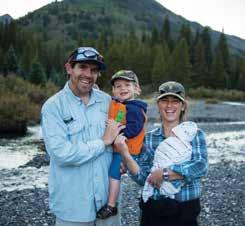

TROUT UNLIMITED has thousands of volunteers throughout the country protecting and fixing the cold, clean, fishable water that makes fly fishing possible in the first place. We restore miles of trout rivers every year. And we work to protect the peace of wild things for everyone. Please join us. Support us. Help make fishing better.



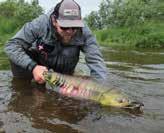



UNIVERSITY OF SOUTH CAROLINA, BARUCH MARINE FIELD LABORATORY, GEORGETOWN, SC
CAPTAIN JORDAN PATE
CAROLINA GUIDE SERVICE, PAWLEYS ISLAND, SC
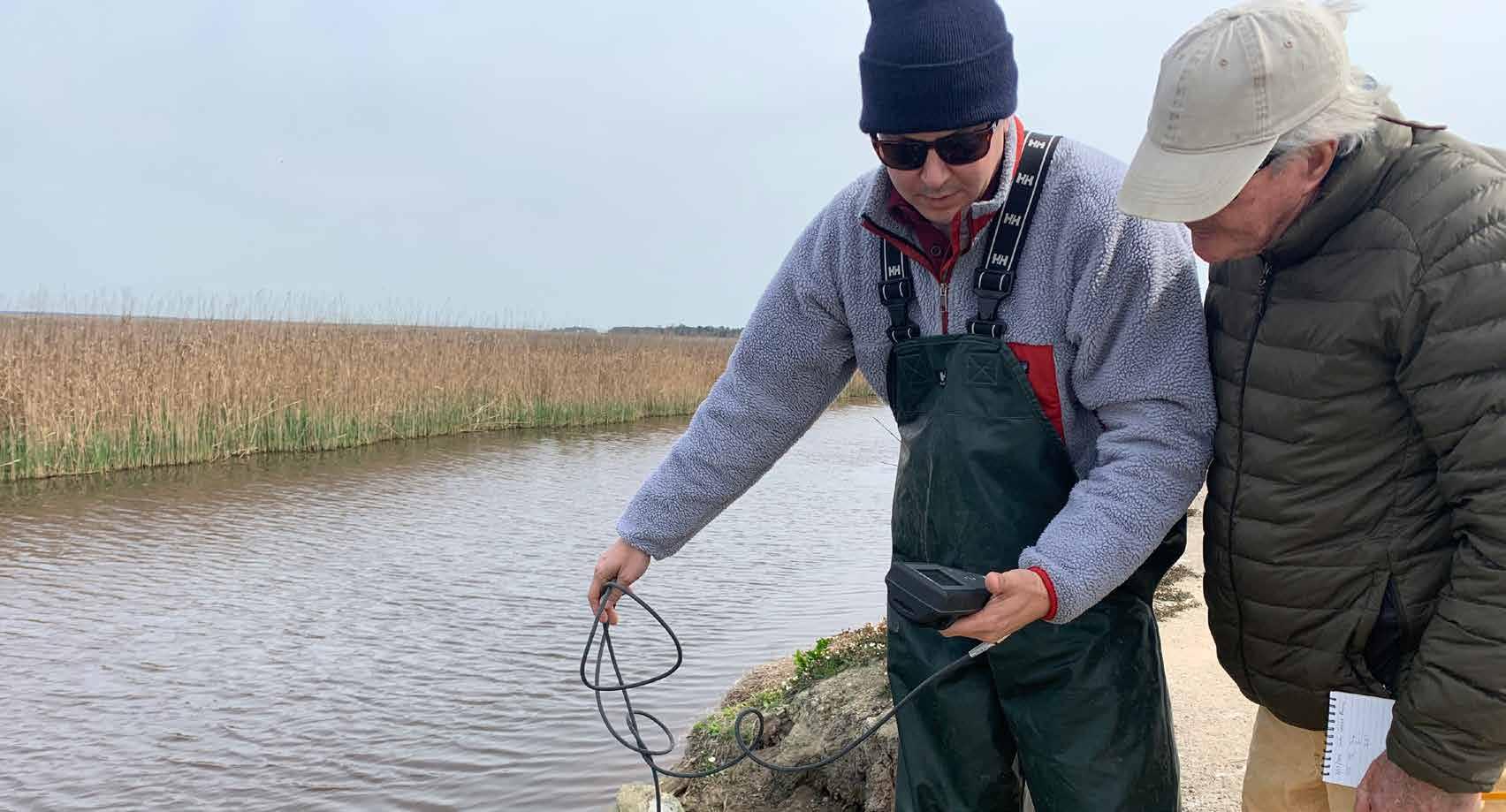
or many years, juvenile tarpon have been observed in inshore and estuarine habitats along the coast of the southeastern United States. Juvenile tarpon are commonly found in small, shallow, tidally-restricted places such as high marsh pools, upland ponds, and marsh impoundments. Despite these reports, few studies have focused on juvenile tarpon in estuaries north of Florida. Recent research funded by Bonefish & Tarpon Trust and conducted by scientists at the University of South Carolina’s Baruch Marine Field Laboratory in Georgetown, SC, provided the first scientific investigation of juvenile tarpon in South Carolina. Our sampling found that juvenile tarpon arrived in June and stayed in these habitats through November before moving elsewhere for the winter. These tarpon were tagged with passive integrated transponder (PIT) tags to track their movement in and out of marsh impoundments. Many
tagged individuals were detected by the PIT tag antennae as they left the impoundments as water temperatures dropped in late fall. However, a large portion of the tagged tarpon were not detected leaving the impoundment. Presumably, these tarpon remained in the impoundments through winter, and their ultimate fate is unknown. Some juvenile tarpon likely survive in South Carolina to join the larger migratory population. However, the numbers are probably limited, as only small, specific habitats in South Carolina are capable of supporting juveniles through the winter months.
Laboratory studies have found that juvenile tarpon can survive in water temperatures as low as 50°F. Based on these estimates, juvenile tarpon are probably not able to survive in places such as tidal creeks and other open water areas in the northern part of South
Carolina, which regularly experiences water temperatures below 50°F during winter months. However, water temperature in some of the tidally-restricted habitats (many of them altered) where juvenile tarpon are commonly observed may remain above this critical threshold and thus could serve as important overwintering areas. In fact, anecdotal reports suggest that this may be the case: juvenile tarpon have been observed during winter months in coastal South Carolina within upland ponds and marsh impoundments that have little tidal influence. Unfortunately, the extent of these small, shallow, and tidally-restricted habitats within estuaries along the southeastern US coast is largely unknown, and continuous, long-term temperature records are lacking for these locations. Most of the available scientific information focuses on tidal creeks and other open water areas, which collectively make up the majority of aquatic habitats available
within estuaries, and are often mapped in detail and undergo routine water quality monitoring.
To address this knowledge gap, we set out to locate and examine tidally-restricted habitats in coastal South Carolina to determine their potential as overwintering sites for juvenile tarpon. We began a comprehensive survey that involves catching and tracking individual tarpon in potential overwintering habitats and examining the environmental characteristics of these locations. To identify potential sites where juvenile tarpon may survive during the winter, we engaged with local fishing guides, private land owners and managers, and state and federal agencies that manage coastal areas in the region. Over the course of the study, which began in the fall of 2018 and continued through the winter and into the spring of 2019,
Following additional tips on juvenile tarpon sightings, we have identified locations to the north and south of Charleston where large tarpon (greater than two feet in length) have been documented during winter months.

we identified and examined over 50 sites spread along 75 miles of coastline from the North Inlet estuary in Georgetown County to the marshes along the Kiawah River south of Charleston. The majority of the sites we examined have been north of Charleston in the North Inlet, Winyah Bay, and Santee estuarine systems. Water temperature at most sites during winter was at or below the low temperature tolerance of tarpon (50°F), but this wasn’t the case for all of the sites. To date, 85 juvenile tarpon (all less than 12 inches in length) have been collected, PIT-tagged, and released at sites in the North Inlet and Winyah Bay estuaries, as well as in the marsh impoundments around Kiawah Island. We have not yet recaptured any tagged tarpon at these sites.
Following additional tips on juvenile tarpon sightings, we have identified locations to the north and south of Charleston where large tarpon (greater than two feet in length) have been documented during winter months. The large size of these individuals suggests
successfully overwintered. We plan to investigate this further through the summer and fall of 2019 and hope to continue to identify other new sites in the region as well.
Overall, our preliminary survey results suggest that sites where tarpon can survive winter in South Carolina most likely share certain characteristics. These are places largely cutoff from regular tidal influence, either through water control structures or by being perched higher up in the marsh platform, so that they are not inundated by tides on a daily basis. Also, these sites appear to be mostly shallow (around three feet or less) with at least a few deep holes (six feet or more), where tarpon may congregate when shallow portions get cool during the winter.
Ultimately, we could not conduct this research without the helpful input we have received (and continue to receive) from anglers, fishing guides, landowners, and resource managers. We thank all involved and look forward to providing another update in the near future.



When did you learn to fly-fish and how long have you been guiding? I’ve been guiding 23 years now, and I learned to fly-fish about 26 years ago.
If you had to choose just one bonefish fly to use from now on, what would it be?
I would choose the Gotcha. The Gotcha is my go-to fly. You want a lighter one with bead-chain eyes and a heavier one with lead eyes for fishing in different depths of water.
What makes the East End of Grand Bahama Island such a special place to fish for bonefish?
The eastern end of the island is special because we can easily fish two different tides at the same time. If you go to the northern side and the water is coming in, you can run about five minutes away to the south and the tide will be going out. So you always have options when fishing the East End.
How did you get involved with BTT’s bonefish conservation work on Grand Bahama?
I got involved through Justin Lewis (BTT Bahamas Initiative Manager). I learned that he was going out and doing research on bonefish, which are my livelihood. was excited to see someone who had an interest in researching the fish. That made me really want to be interested and help out in any way I could.
What research projects have you helped Justin with?
I’ve helped him with tagging bonefish and collecting bonefish to study right before they spawn. I’ve also helped teach the guides how to properly handle them.
How has the restoration of August Creek helped Grand Bahama’s bonefish fishery?
It has helped quite a bit. I now see bonefish moving around there and I have seen tarpon back in that creek too. I think the restoration work helped keep the whole creek from dying. Water is flowing through and life is coming back to August Creek and other areas.

How did you learn to fish? Was it always a passion of yours?
I was fortunate to grow up in West Palm Beach plug-casting for snook, jack crevalle, and whatever else would smash a Zara Spook. When I reached high school, I started to mate on charter boats out of Sailfish Marina on Singer Island. Upon graduating from the University of Central Florida, I was ready to get back to my passion for fishing. Within a week of graduation, I had my bags packed for the Lower Keys. I was able to get a job on a charter boat out of The Ocean Key House in Key West.
How long have you been a flats fishing guide?
Last tarpon season marked my 25th year of guiding. While many people would consider that a long time, it is actually a blink in the grand scheme of time. I have been very fortunate to spend my years with great people and witness many spectacular sights that will forever be carved in my mind.
What changes in the Keys’ environment and/or the flats fishery have you seen over the course of your career?
In 25 years, I have seen changes to our fishery and environment that make me realize just how fragile our ecosystem is. I often think, where will we be in the next 25 years? Between degraded fish stocks, poor water quality, dying seagrass beds, reef disease, increased boat traffic and fishing pressures, we have our work cut out for us. The good news is that we can make a difference. We have proven that fishery managers listen and respond to us.
In your role as president, what are your goals for the Lower Keys Guides Association?
As president of the Lower Keys Guides Association, my role is to work with our members, the Florida Fish and Wildlife Conservation Commission, and the Florida Keys National Marine Sanctuary to help maintain and improve our fishery. My goal for the future is to ensure that we can have a sustainable resource through sound management practices.
Why should fellow guides and anglers be involved in the conservation of bonefish, tarpon, and permit?
With the help of fishing guides, anglers and BTT’s science and data collection efforts, we will continue to learn more about our fishery and the important changes that will bring us closer to our goal of sustainability.
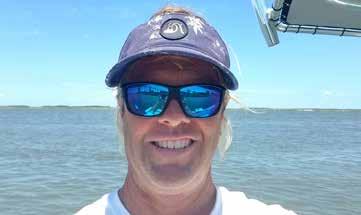
How long have you been a guide?
I have been a guide on Amelia Island for 16 years.
What is your favorite fly and lure for tarpon?
My favorite fly is the Dave Edwards’ Purple Poison and my favorite lure is anything in the DOA saltwater line.
What environmental issues have you faced where you fish and how have they affected the fishing?
Every summer we experience a thermocline in North Florida. It has gone from being an occasional occurrence to an expected one and is a direct result of global warming. It affects the fishing in that the fish leave the area as a result of the low water temperatures.
Why did you decide to get involved with BTT’s tarpon research?
BTT’s tarpon research has provided me with the opportunity to be able to track the movement of tarpon in my highly migratory area. am very interested in migration patterns, population density and overall health of the fishery.
As a guide, why do you feel that the conservation of Florida’s tarpon fishery is important?
As a guide, I feel that the conservation of Florida’s tarpon fishery is important for our future generations, as well as the present ones. I would say that 50 percent of my customers are children and I want to make sure that they will be able to have the same experiences with their own children as well.
Best tip for catching tarpon on fly? Stealth is the key to catching tarpon.

How long have you been a guide, and where do you fish? I have been a full-time fishing guide since 2012. I fish the Middle and Upper Keys, Biscayne Bay, and Everglades National Park.
What environmental issues have you witnessed in the Keys or Biscayne Bay and how do you think the flats fishery has been impacted?
I’ve noticed the fishing has gotten worse in Biscayne Bay since I first fished there when I was in college at the University of Miami in the early 2000s. It’s still as good as it gets in terms of being able to catch big bonefish, tarpon, and permit, not to mention snook and redfish, all in the same area, but I remember it being even better 20 years ago. I think the proximity of so many homes and developments, as well as the continuing salinity pollution discharging from the Turkey Point power plant all have an impact. hope we can figure out how to protect our fishery before we cross the point of no return, whenever that is.
Why did you decide to get involved with BTT’s permit and bonefish research?
I make a living helping people catch permit and bonefish, so I’m all for trying to protect them and figure out how to ensure their long-term survival and viability in the Keys and Biscayne Bay. Helping out with the research is also a way of leaving a legacy for the next generation of fishermen in the Keys. was lucky enough to grow up fishing down here as a kid. Some of my best memories in my whole life are of being out on the water with my dad and grandpa chasing fish; I hope to be able to leave my kids and grandkids with those same memories.
As a flats guide, why do you feel that anglers should be involved in the conservation of bonefish, tarpon, and permit?
If these fish don’t survive down here, we’ll just be a bunch of people going out for boat rides. We get so much pleasure and happiness from being out on the water and interacting with the natural environment, so it seems only fair that we do our part to protect that environment and the fishes in it. I think if you’re a fisherman, especially a flats fisherman down here in the Keys, you’re somewhat of a thief if you aren’t actively participating in some way to help protect bonefish, tarpon, and permit.

TONY L. GOLDBERG, PH.D., DVM
PROFESSOR OF EPIDEMIOLOGY, SCHOOL OF VETERINARY MEDICINE AND ASSOCIATE DIRECTOR FOR RESEARCH, GLOBAL HEALTH INSTITUTE, UNIVERSITY OF WISCONSIN-MADISON
Question: What do lowland gorillas, Tasmanian devils, little brown bats and golden toads have in common?
Answer: All of these species have been decimated by infectious disease. Ebola caused massive mortality in gorillas in Central Africa in the early 2000s, a strange transmissible cancer reduced Tasmanian devils to a fraction of their original population in the 1990s, and white nose syndrome has put the once-common little brown bat at risk of extinction across North America. And chytridiomycosis, a fungal disease that swept through Central America in the late 1980s, sounded the death knell for the golden toad of Costa Rica’s cloud forest, which is now extinct.
So, what does this have to do with bonefish? That’s what we’re trying to find out. Infectious diseases (diseases caused by microbes) in wildlife were once thought to be like bad weather or a dip in the food supply—disease would come, do some damage, then disappear and populations would bounce back. But today, there’s a new view.
It’s kind of like Godzilla—disease can seem to come out of nowhere to cause mayhem all by itself. Emerging infectious diseases don’t come from nowhere, of course—they come from other species, other places, or from mutated versions of familiar germs. But they can cause permanent population declines or even extinctions if left unchecked.
Could disease be impacting bonefish in places where their populations have crashed, like in the Florida Keys? To be sure, there are many possible causes—habitat loss, climate change, overexploitation—that are likely contributors. But there’s a problem with these explanations by themselves: These are ecosystem-level issues that should impact all species to some extent. But other flats species, such as permit and tarpon, haven’t suffered the large-scale decline like bonefish, and non-gamefish species that share the flats with bonefish, such as mullet, mojarra, and checkered puffers, are doing fine. This points to a disease as a possible culprit since a disease can affect one species and not others.

So, it’s not just a matter of understanding bonefish germs—it’s actionable science that will aid conservation and help us understand the challenges facing the Florida Keys bonefish population.
Infections can be very specific with respect to the hosts they attack. For example, if you have the common cold, your dog is not at risk. Many microbes, and especially viruses, have learned to exploit particular hosts over the course of their evolution.
Right now, we know basically nothing about bonefish health and disease. In part that’s because, if a bonefish population got sick, we wouldn’t expect to find a pile of dead fish—sharks, barracudas, and other predators would take advantage of weakened bonefish in short order. We’d just notice one day that the fish aren’t there anymore, or at least not like they used to be. Or disease could reduce the ability of bonefish to reproduce, which would result in a declining population over time as fewer juveniles were produced to replace older adults.
In the case of bonefish, we need to begin by measuring the health of normal, healthy populations so we can use that information as a baseline for examining populations that are not what they used to be. We also need to consider how disease works in tandem with the usual suspects of habitat loss, climate change, water quality reduction, and other ecological drivers.
A few years ago, we were able to take a first look. We focused on the gills (a common place for nasty bacteria to attach in fish) and the blood (where viruses often lurk). With a small pilot grant and the dedicated help of BTT’s network of scientists and anglers, we sampled fish in the Florida Keys and in the Bahamas. Back in the lab, we conducted “microbiome” analyses of gill samples (that’s a way to get a picture of the entire community of bacteria) and “metagenomics” on bonefish blood (a way to “hunt” for unknown viruses). Both methods are yielding fruit. Bacteria on the gills of bonefish in the Keys are strikingly different from those in the Bahamas, and some bacteria in Keys fish are associated with disease.
We’ve also found at least one previously unknown virus in bonefish and we’re trying to understand more about it.
We’re now in Phase 2 of the study to expand our sampling to new areas throughout the Caribbean, increase the number of samples from the Florida Keys, and deepen our analyses in the lab. Our objective is to generate the first description of bacteria and viruses in bonefish across the Caribbean so we can begin to understand what’s normal, what’s abnormal, and what to look for as telltale signs of ill health in bonefish populations.
Importantly, this work will help us conserve and manage the species. For example, if we find diseases in certain bonefish populations but not others, we’d better consider how to keep those diseases contained. This is familiar to those of us who fish for trout and know how important it is to clean our gear between rivers, but have you
ever seen similar precautions at a bonefish lodge? If populations are sick, we’d better think about minimizing pressure on them until they recover. If we find a “smoking gun” disease, there are even some new and promising technologies available for controlling it—vaccination or probiotics, for example. So, it’s not just a matter of understanding bonefish germs—it’s actionable science that will aid conservation and help us understand the challenges facing the Florida Keys bonefish population.
It won’t be easy—it’s hard enough to understand human disease even with all the resources of the National Institutes of Health and other funding behemoths that support human health research. We’re working at the edges of scientific knowledge on a species about which very little is known, sometimes in remote locations. But we need to know. Baselines of bonefish health may be shifting right under our feet, and if we ignore that possibility we do so at our peril.
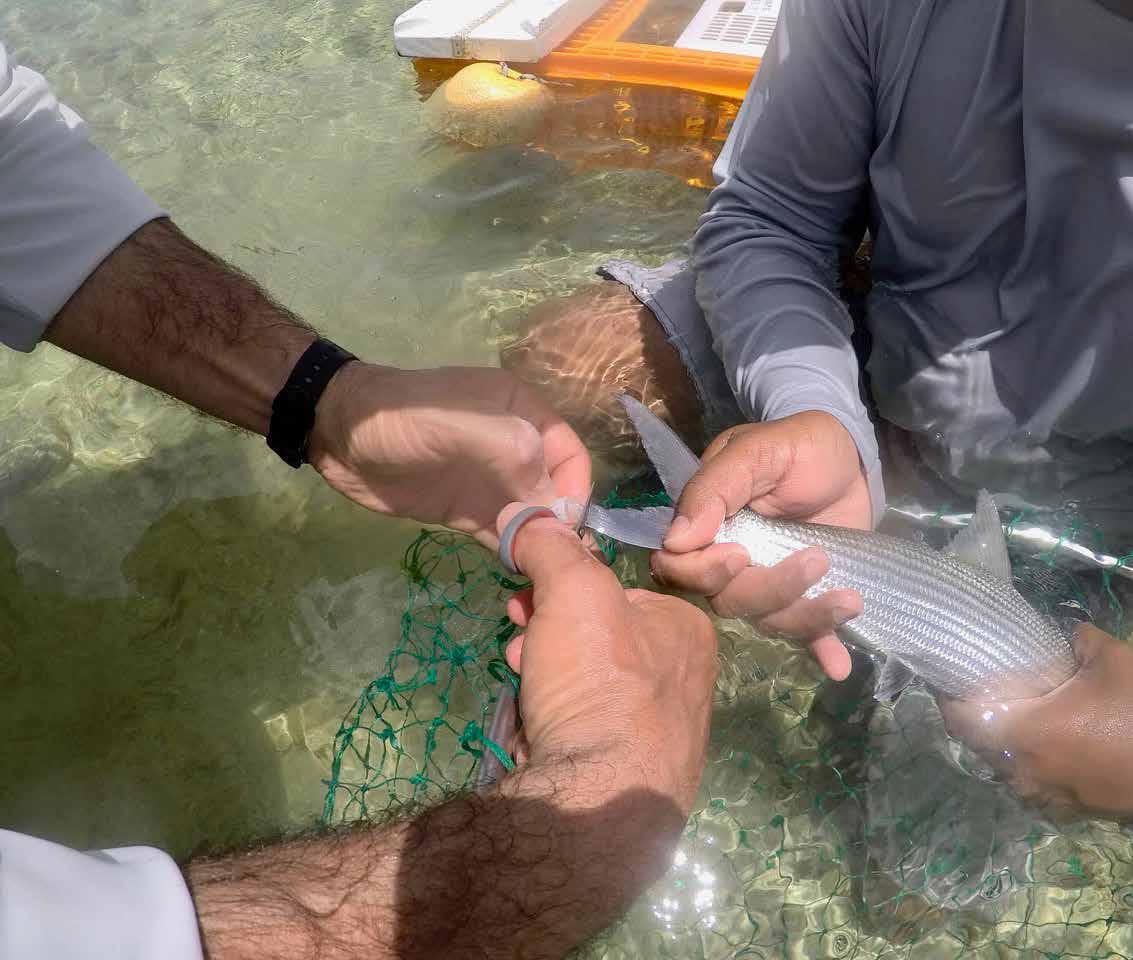
There is no discernable line between fishing and painting in C. D. Clarke’s ecosphere. I know this from countless, memorable trips alongside him spanning about 30 years across the globe. On the water with him, I’ve come to recognize a certain twitch he shows when the fishing is good, but the light is better, and he makes the decision to put down the rod, remove his backpacked easel, canvas, brushes, rags, and paints to capture the scene en plein air. It’s marvelous to watch as he recreates the tableau of color, light, motion, and possibility—leaving out what doesn’t matter and distilling the rest into the pure emotional moment. The results are more true and complete than memory can maintain. This is why we make wall space to hang these significant recollections of a life well-lived.
Longtime friends and patrons like me call him Chris. These days, people, including his wife, call him C.D. While he’s more likely to respond in kind to a wild turkey yelp, he will answer directly to either given name unless he’s tying flies, dressing a deer, stalking a bonefish, cooking the catch, or painting under the pressure of a setting sun. Sometimes it’s best to leave him alone.
He grew up roaming, fishing, and hunting the woods, Finger Lakes, and streams of upstate New York. While progressing from creek chubs to trout, doves to ducks, and rabbits to deer, he discovered the artists who would bolster his passions. From the covers of Field & Stream, Gray’s Sporting Journal, Sporting Classics and the like, he found Ogden Pleissner, Chet Reneson, John Swan, Thomas Aquinas Daly, the best— and he began to develop his style. I recall maybe 25 years ago when I asked why, and he said emphatically, “I was born to paint…and fish…and hunt.” No qualifiers. No second-guessing. Just the certain awareness of what he is compelled to do.



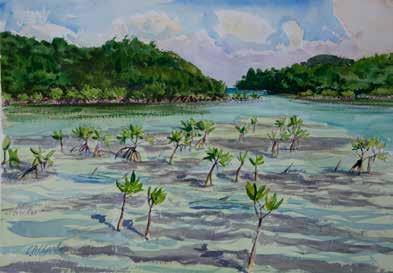
This, by-the-way, ignites sparks of jealousy in those like me who are still sorting out career paths and bucket lists over a half century on the trail.
Clarke enrolled in the Syracuse University Visual Arts Program and graduated on schedule with a BFA in 1981, and then moved to Shelter Island to paint and fish while paying his dues on the back of a garbage truck and waiting tables. Striper and weakfish populations flourished at the time, and he committed himself to the salty culture of the East End of Long Island and the pursuit of fish and light. Over the next decade, his paintings attracted attention and invitations to travel and squeeze-out learning opportunities on location. Eventually, rampant development in the area convinced him to look elsewhere for a place to work, essentially leaving the market to find broader vistas. After a pinball tour of the Chesapeake Bay’s eastern shore, from Cape Charles to the Chesapeake Bay Bridge, he settled on a marsh-level, Maryland location and a house on a single-lane road in a remote maritime community on Prickly Point, which juts into the mouth of the Manokin River and Tangier Sound, an arm of the Chesapeake Bay. Here, he built his studio, home-base for adventure travel, and a respite for visiting sports and vagabonds to stay and experience the Chesapeake’s excellent water-fowling and angling options.
As his skills and reputation developed, broader opportunities and connections materialized. He generally stayed home for the waterfowling seasons, but otherwise traveled north for Atlantic salmon and south to the Keys and Bahamas for bones and tarpon. Along the way, he fell in with other burgeoning artists to compare notes, offer challenges, and share the journey, notably Walt Matia, Tim Borski, and Gordon Allen; compulsive creators who have also risen to the top of their mediums.
Thus began a continuous global sporting and painting tour, which have occasionally benefitted from by tagging along to the Florida Keys, Everglades, the Los Roques archipelago, the Kola Peninsula, the Chilean Aysén Region, the Carolina marshes, New Jersey’s wild rice meadows for Sora rails, and all around our Chesapeake backroads, ditches, corn fields, rock piles, oyster reefs, and swamps. Outside of these memorable jaunts and capers, he has gotten to know and paint Sub-Saharan Africa, the Bahamas, Britain’s chalk streams, Scottish Spey waters and distilleries, The Seychelles, Tierra del Fuego, the Andes, Christmas Island, Argentina, Icelandic salmon streams, a swath of the Caribbean Islands, Labrador, Newfoundland,
British Columbia, Cuba, and annual trips to Thomasville, Georgia. Recently he achieved and painted the wild turkey grand slam by bagging all four U.S. subspecies—eastern, Osceola, Rio Grande and Merriam’s in one calendar year. Crazy.
Along the way, his work has flowed out to galleries, shows, and finer wall spaces around the world such as the American Museum of Fly Fishing (“A Painter’s Angle” solo show, 1995), the Leigh Woodson Birds in Art Show, the Thomasville Plantation Wildlife Arts Festival (23 years), the Easton Waterfowl Festival (10 years), and the National Sporting Library and Museum. On a recent assignment to an extraordinary private Eastern Shore hunting preserve, walked into the lodge’s dining room to find an entire wall dedicated to C.D. Clarke watercolors. There are even more in the bar.
Meanwhile, his work has turned up on the covers and pages of books and the very magazines he hoarded as a youngster—Gray’s, Sporting Classics, Shooting Sportsman, Fly Fishing in Salt Waters….
These days, he maintains a base and studio in the New Jersey Highlands near the upper Raritan River with Tracey, who fortunately loves and lives to fly-fish, wherever that takes them.
Several years ago, I put together a Lefty Kreh tribute in Annapolis to celebrate the man and raise money for Chesapeake Bay conservation. Clarke immediately stepped up with two large originals, painted for the event, featuring Lefty and Flip stalking a rolling tarpon. One sold at the list price before the event, the other went in a heated auction round and now hangs in the famous Boatyard Bar & Grill. Meanwhile, he has contributed to countless other conservation initiatives—Trout Unlimited, Coastal Conservation Association, Chesapeake Bay Foundation, Ducks Unlimited, the Ruffed Grouse Society, Tall Timbers Research Station, Atlantic Salmon Federation and, of course, Bonefish & Tarpon Trust. He’s an Atlantic Salmon Federation board member and a BTT New York Dinner committee founding member.
The point is, it’s his business and passion to preserve for us these priceless moments in the wild while doing all he can to ensure that these opportunities will persevere in spite of all that stands in the way.
Joe Evans is the editor in chief of Chesapeake Bay Magazine, based in Annapolis.
In the Bahamas, bonefish spawn from October through April, usually around full moons. During this time, fish school by the thousands at staging areas called pre-spawning aggregation sites, or PSAs, which are six to 40 feet deep. After gathering together, the bonefish porpoise and gulp air at the surface as part of a complex pre-spawning behavior before migrating offshore at night to spawn. They descend hundreds of feet to spawn in open water that is thousands of feet deep.
“If the fish don’t have the ability to engage in their behaviors at PSAs and be safe at PSAs, they’ll never make it to the offshore spawning site,” said Dr. Aaron Adams, Bonefish & Tarpon Trust’s Director of Science and Conservation.
Reaching a PSA is most likely the longest journey a bonefish will undertake. Their home range can be less than a mile, but they’ve been tracked migrating 70 miles or more to spawn. Turn their farthest route into an impossible route and you throw a major block in their ability to spawn.
“If there are no more PSAs, there are no more bonefish,” Dr. Adams said.
PSAs are at risk in various ways. From boat traffic and coastal construction to water pollution and dredging, as well as netting. Chances are, if any of that is happening somewhere in the Caribbean, it’s affecting the bones in the flats you know because those flats get their fish from other places.
“A fish might be spawned in Abaco, but there’s no guarantee it’s transported back to Abaco,” Dr. Adams said. “That’s why you need local protection to protect where the larvae end up, as well as protection where the larvae are spawned, and that means regional protection.”
Like many marine fishes, bonefish rely on ocean currents to transport their larvae after spawning. By spawning offshore, bonefish larvae are immediately in oceanic currents. This explains why the bonefish populations throughout the Caribbean are genetically related; although some larvae end up being transported by currents back to their parents’ island, many are transported long distances.

This means, for example, that some bonefish larvae spawned in Belize and Mexico end up in the Florida Keys. And that bonefish spawned on the north coast of Cuba may end up in the Bahamas, and that some Bahamas-spawned larvae end up on the north coast of Cuba.
“The whole Caribbean basin is interconnected,” said Justin Lewis, Bonefish & Tarpon Trust’s Bahamas Initiative Manager. “PSAs within that basin are the focal point of bonefish life history. If you take away those staging areas before they head out to spawn, you’re not going to have future generations.”
In the Bahamas, five national parks and one park expansion protect bonefish migration routes and foraging habitat. Two of the five and the expansion also protect PSAs. Six protected areas are more than a handful, but still less than what the bonefish population needs. BTT is in the midst of an intense effort to find more PSAs that need protection and learn more about the spawning process.
“Bonefish migrate from all these different places so how do they know when to show up?” Dr. Adams said. “They can’t communicate with one another, but they all show up at same spot at the same time.”
About 10,000 bonefish show up at the Abaco PSA in November. It’s a massive swirl of fins that hovers as a large, dark cloud in otherwise aquamarine water. Sounds obvious enough, but it took four years to find. That was in 2011. Seven more PSAs have been found since, with two discovered in 2018. Researchers are refining their methods, enabling them to locate PSAs faster.
They’re making progress as a whole, but break down the eight PSAs documented. Only three of the eight are within the boundaries of new park designations set aside in recent years. Those designations prevented sand mining and marina development on top of bonefish, but only within protected areas. The number of undiscovered PSAs existing unprotected is unknown. The unknown is vulnerable.

“The biggest threat to bonefish in the Bahamas is habitat loss and degradation,” Lewis said. “Shoreline development removes habitat and increases boat traffic, displacing fish populations.”
It’s unrealistic to go for blanketed protection across islands, but establishing management areas around PSAs could work. That’s the next step following on the heels of successfully creating national parks in the Bahamas because having a way to protect PSAs as they are discovered is vital to the health of the fishery.
“It matters because bonefishing is a valuable renewable resource worth hundreds of millions of dollars a year in the region,” Lewis said.
“And within Bahamian culture bonefish are important. If you take them away, we’ve lost a significant part of our culture.”
BTT is working to better understand fish biology and rushing to identify additional PSAs so that regulations can be enacted to ensure a healthy fishery for bonefish—and anglers.
Outdoor journalist Kris Millgate is based in Idaho where she runs trail and chases trout. Sometimes she even catches them when she doesn’t have a camera, or a kid, on her back. Her first book My Place Among Men publishes in August. See more of her work at www. tightlinemedia.com.


The first glimpse that visitors to Mexico’s Yucatán peninsula usually get is on the flight into Cancún. If you’re lucky, you’ll come in from east of Isla Mujeres, descending over the thick, saturated greens and blues reflected by the shallow Caribbean Sea. Then suddenly you’re flying over an eruption of massive beachfront resorts, housing tens of thousands of ant-sized vacationers, just before touching down. This is about all that millions of annual visitors will ever get to see of the Yucatán but, with some effort and time, there is another world to be experienced.
The Yucatán is a blocky outcrop attached to Mexico’s east coast, running from the Bay of Campeche in the north to the Belizean border in the south. The eastern coast is known for its mega resorts and their beautiful coral sand beaches edged by calm, turquoise, gin-clear waters. The resorts crowd the water’s edge in an almost uninterrupted
chain from Cancún southward through coastal towns and cities. A single highway is the only artery that feeds these vacation hotspots. It’s almost two hours south by car before things begin to slow down and the road finally funnels into the quaint beach town of Tulum. The town is famous for its seaside Mayan temple ruins but has more recently become known as a hip, holistic hideaway featuring yoga retreats, meditation, and health food restaurants, offering a fresh alternative to the madness father north. Tulum also sits at the northern gateway of a natural expanse that is one of the finest examples of a virtually untouched ecosystem anywhere in the world, the Sian Ka’an Biosphere Reserve, an ecologically protected area covering more than one thousand square miles.
In the Mayan language Sian Ka’an means birthplace or origin of the sky. It’s thought to refer to the daily sunrise over the ocean as the sky A school of bones feed in
is reborn from the previous night’s darkness. Tulum, sitting just outside the reserve, is the last sense of civilization for those wanting to visit Sian Ka’an. From there on it’s a bumpy, rocky ride down a difficult dirt road to the true last stop, Punta Allen. Punta Allen is the quintessential sleepy little fishing town literally at the end of the road. Its dusty sand streets are lined with coconut palms with vistas of the ocean across white sand beaches. Day visitors on bus and Jeep tours fill the openair seaside seafood restaurants, gobbling down fresh, inexpensive seafood and guzzling cold Mexican beer, their shadowed forms visible under the thatch palapas, silhouetted against the long rows of pangas moored off the beach. A few small, low key resorts dot the village, catering to vacationers wanting to snorkel or take trips into the reserve to see mangroves or dolphins. But for the real clue to what makes the town tick, one doesn’t have to go farther than the giant stainless steel sculpture in the center of town. Punta Allen is home to some of the best-known fly-fishing operations in the Caribbean. Their reputations were forged primarily on the quest for just one species, the one that’s memorialized in stainless steel in the streets of Punta Allen: the permit.
As part of the Sian Ka’an Biosphere Reserve’s extensive management plan there are several provisions to use resources sustainably in order to preserve this magical place for future generations. There are local lobster fishing co-operatives, tourism initiatives involving land and sea-based tours, and catch and release fly-fishing. Among all of the tourists who enjoy using the reserve, it’s the fly-fishermen who penetrate the deepest into the world of the Sian Ka’an and get to see the most of its true beauty.
The reserve itself is flanked on the east by the Mesoamerican reef, one of the largest coral barrier reefs in the world. It has its origins in the Bay Islands of Honduras and stretches nearly 700 miles along the Central American coast ending in the northern Yucatán. The seaward edges of this reef border a great deep-sea trench, the shallow reef-top dropping almost vertically into an abyss almost 10,000 feet deep in some spots. The sunlight-dependant coral has grown for millennia in the shallows building up fortifications against the open sea, calming the giant roaming swells.
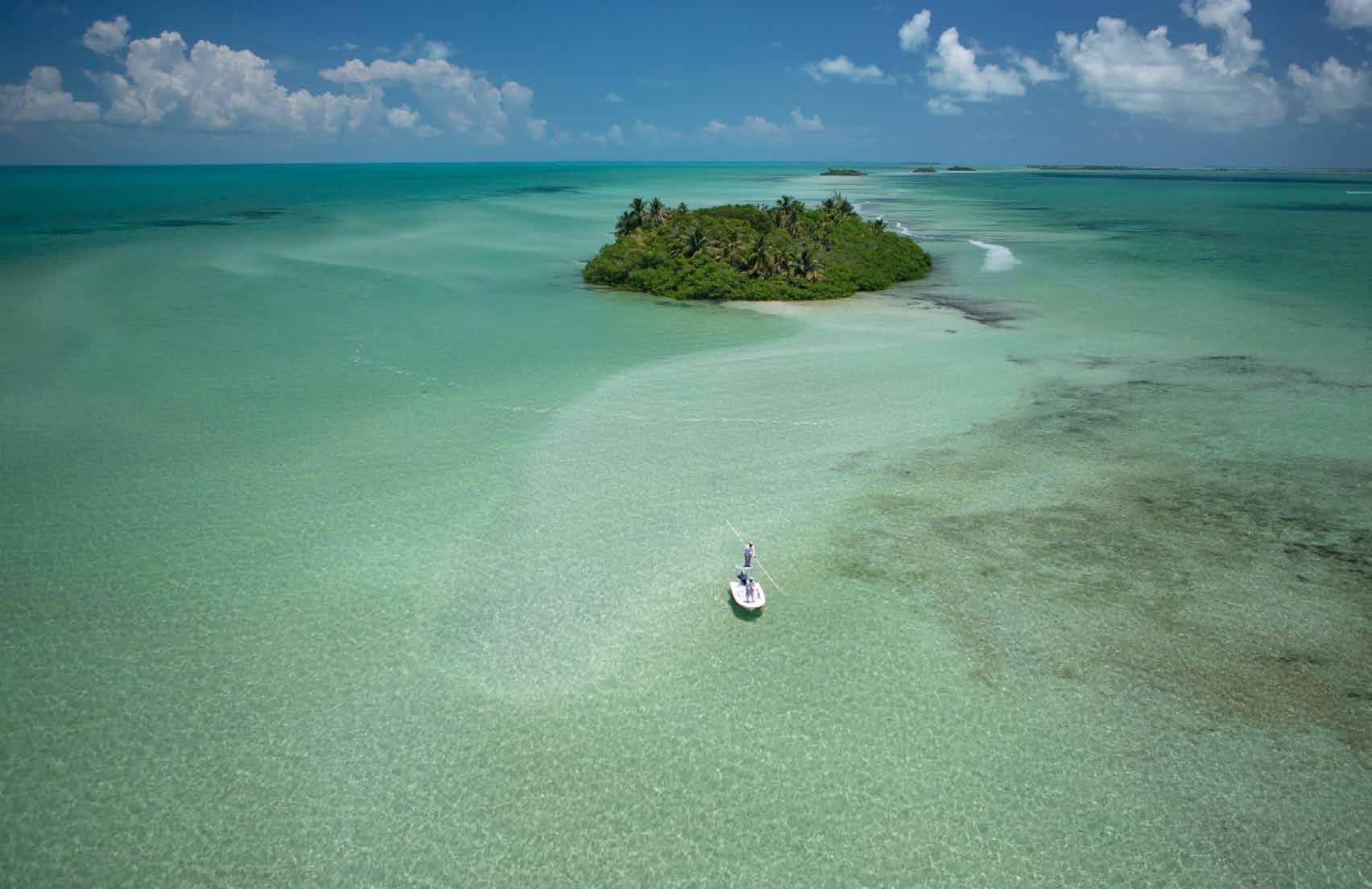
Inside the reef on its western facing side, the calmer waters provide protection for more delicate reef growth and environments for fish and animals to thrive. The barrier is not, however, one monolithic block stopping all. It has numerous cuts and channels, pathways for the daily life of the reef to pass between the inside and the open ocean like a porous membrane.
The other geographical structures that make the Sian Ka’an unique are two gigantic bays that cut deep into the otherwise constant featureless shoreline. In the north is Ascension Bay, and in the south Espiritu Santo Bay. They are divided by the 15-mile-long island of Punta Pajaros, its eastern shore almost seems to push each bay apart as if with outstretched arms. The island is connected to the mainland by a spider’s web of mangrove swamps and shifting sand bars dense enough to act as a barrier between each bay. There are two sister flyfishing lodges located on Punta Pajaros, Casa Blanca on its northern tip and Playa Blanca on the southern end. Each lodge is positioned for prime access to each of the bays. These lodges are accessed from a private airstrip located on a small cay just north of Casa Blanca. Basic whitewashed and thatched structures, both of these lodges are the only resorts in the heart of the reserve. They cater to a very small group of fisherman but their high tariff/low impact catch and release fly-fishing model fits perfectly with the management plan for Sian Ka’an.
Each bay has its own unique character, but what they have in common are the mechanics of 11 different eco-systems and how they interact with one another. Think of these bays as giant lungs, the tide their constant breath. From the western borders of the reserve through one of the region’s largest tropical forests flow thousands upon thousands of rivulets, natural canals, and waterways. From the air they resemble veins and arteries delivering fresh water into the reserve, much of it visible from above as the land intersects the complex water. The Yucatán is made of limestone and has one of the largest underground river systems in the world, so that much of the water from outside passes into the reserve underground and unseen. Mostly hidden from view by the impenetrable forest, secret entrances lead below
As incredibly beautiful and diverse as the Sian Ka’an is, no matter how good the management plan for the reserve, there are ongoing threats to its existence. Most can be traced back to man, the most obvious being climate change.
ground into an extensive cave system that allows access to these underground lakes and rivers called cenotes. These dark recesses below ground support their own unique ecosystems. Combined with the other ten ecosystems in the reserve they form a matrix of life from the tiniest organism to the birds and large mammals that use this habitat mosaic to complete their lifecycles. The larger the intact habitat, the more complex and layered the interactions. This is truly the importance of a little-disturbed environment like Sian Ka’an.
Permit are the “hero” species of the reserve and the reason so many travel to the area. They are elegant and graceful but neurotic. They become like a drug to fly-fisherman who go crazy forsaking all else for their next permit fix. The permit spawn offshore outside the reef, and the larvae are washed over the reef and collect along the shallow east facing beaches. Here the juveniles will school and grow until large enough to safely move onto the sandy flats to hunt along the bottom for crabs and crustaceans.
The islands of Tres Marias and Iguana form the perfect backdrop for a skiff. Photo: Marc MontocchioIn addition to permit, there are two other species of fish that attract the visiting fly-fisherman, bonefish and tarpon. Schooling bones are common in both bays and are generally easily found by the expert guides. They spawn offshore, returning back to the shallow flats for the majority of their lifecycle.
Perhaps the most interesting fish of the three, from an ecological point of view, is the tarpon. A prehistoric, big-scaled beast with an upturned jaw, understanding the tarpon is pivotal to understanding the mechanics of the reserve. What makes tarpon so interesting to scientists working to protect areas like Sian Ka’an, is that it is an umbrella species. Because tarpon require so many different parts of the habitat mosaic for their lifecycle, by protecting this one species you by default protect so many others at the same time. The tarpon is unique in that the large adults will cruise past on a seasonal migration often in the shallows inside the reef, where there’s ample food to trap in the sloping surf zones. The larval phase tarpon spawn is carried by the tide deep into the brackish channels of the bays’ backwaters. The water here is devoid of oxygen and colored dark brown by leaf tannins and detritus. Juvenile tarpon survive by gulping air at the surface, and use their modified air bladder to deliver the oxygen to their blood. Here the juvenile tarpon are safe from many predators and presented with an array of food sources also at home in this primordial soup. As they grow they will come out of the hidden backwater nursery and start feeding on schools of small baitfish found along the shorelines and ocean side mangroves of the sandy islands. Finally, they will leave the bays and join the adult migrations offshore. As the tarpon’s full range is studied and protected we also preserve that part of the matrix used by both bonefish and permit.
These fish might be the big draw of the Sian Ka’an, but it’s the plants that truly do the heavy lifting around here. Fresh water flowing into the bays brings dissolved nutrients and sediment. As these rivers change direction, or are slowed by opposing currents, they begin to drop their cargo. The nutrients help seedlings become trees whose roots take hold. Birds arrive to use the branches as protection and a home for nests. They further fertilize the new soils and life begins in earnest on these small islands of vegetation in an otherwise flat landscape. The mangrove is the architect of these islands of life. The tree is truly a land builder. It appears in the reserve in areas of almost pure fresh water all the way to the ocean in water that’s pure salt. It’s able to extract fresh water and excrete the salt through its leaves. Over time, its branches hang out over the surrounding water, dropping seedpods that float away on the tide to form new colonies. It constantly walks its roots farther and farther outwards, trapping detritus and building more and more solid ground. These mangroves offer protection for a myriad of fish, sharks, insects, and birds, and they will reclaim hundreds of square miles, becoming almost impenetrable in areas of the reserve like Santa Rosa.
Common, especially in Ascension Bay, are white coral sand deposits dumped by tides and currents that have collected to form sand bars and islands. Coconuts that have washed ashore have sprouted into dense palm groves skirted in mangroves. The islands of Tres Marías and Iguana provide an idyllic backdrop to a poling trip to the point of being cliché. It really is that epic magazine cover shot of shallow crystal-clear water and verdant palm trees with a fly-fisherman perched on the bow casting his line—the Disneyland of saltwater fly-fishing.
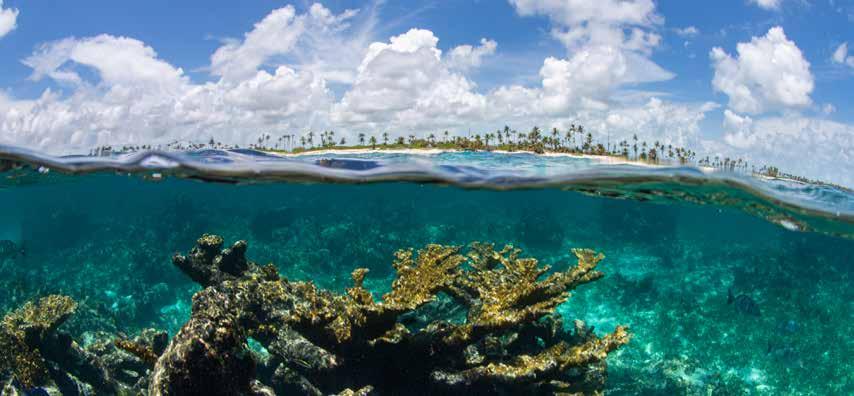
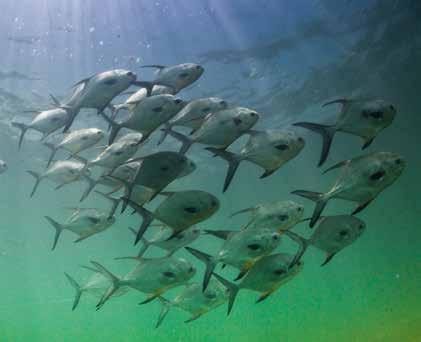


Stepping back for a moment and adding some perspective, there is another important facet that makes the Sian Ka’an Biosphere Reserve so incredibly special and that’s the people. The indigenous Mayan people have inhabited the area since before the 15th century. Their language and culture is evident throughout the reserve in the ruins of the past but also in the language and culture of a very modern people. Many of the fishing guides and people living in the reserve today are of Mayan descent and they still proudly speak and live the traditions of the ancient inhabitants. This part of the Yucatán is the heart of the Mayan people in Mexico. Ancient Mayan-controlled waterways through the dense mangroves still exist. Originally used for trade, now poled by flats skiffs and pangas, there are places where around a sharp bend in the narrow canal, under a solid canopy of trees, one suddenly comes across a Mayan ruin, the brightly painted facade of jaguar heads and snakes long since gone except for a few chips and weather-dulled features. It doesn’t take much imagination to realize where you are and put into context the history of this place and its people.
As incredibly beautiful and diverse as the Sian Ka’an is, no matter how good the management plan for the reserve, there are ongoing threats
to its existence. Most can be traced back to man, the most obvious being climate change. A sea-level rise of just inches will put much of the current reserve and its inhabitants at risk. Pollution is another serious threat; from the ocean comes a daily assault of ocean borne plastic, the majority of it not even from Mexico. Trash from throughout the Caribbean, thousands of plastic cups and other plastic junk is carried into the Sian Ka’an on the same ocean currents that bring in nesting turtles, and it’s all deposited on the same beaches as their eggs. From the land comes the pollution from human development outside the park carried by the multitude of underground rivers. Add to that poaching, invasive species, fires, and many more long-term threats, and the survival and health of the reserve is by no means guaranteed.
But the effort and plan to preserve it continues. And protecting the Sian Ka’an provides us with one very special thing, hope. Hope that areas of the world like this one matter enough to humankind to be saved. Hope that the past has not been forgotten. Hope that the living culture of the Mayan people continues to play a role in the future of the reserve. Hope that the fish that every fly-fisherman loves so much has a place to live and thrive when so many other habitats worldwide are being lost.




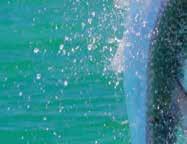



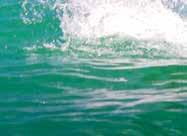


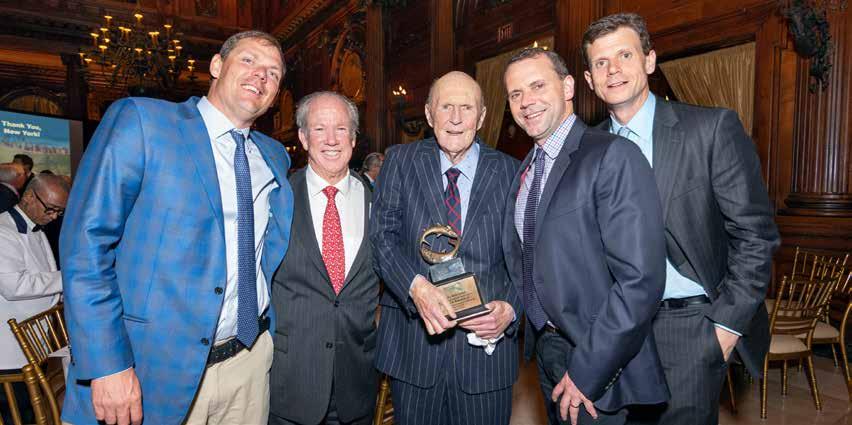
Julian Hart Robertson Jr. received the Lefty Kreh Award for Lifetime Achievement at BTT’s 8th Annual New York City Dinner and Awards Ceremony on April 9, 2019.
Robertson is best known to many as founder of Tiger Management Corporation, one of the earliest and most successful hedge funds, but rivaling his legendary Wall Street career is his legacy of leadership and generous support to important charitable causes. He and his family, through the Robertson Foundation, have aided organizations focusing on education, medical research and the environment with transformative philanthropic investments, enabling them to respond to some of the greatest opportunities and challenges of our day.
Counted among his many contributions to the environment are significant commitments to advance conservation causes at Everglades National Park, improve management of menhaden, and groundbreaking research into bonefish reproductive biology and tarpon migrations. CEOs from several leading conservation organizations joined BTT in making tributes to Robertson.
“Julian Robertson has shaped the face of environmental protection

and conservation in the United States and beyond. And he has done so in ways that are profound yet often quiet,” said BTT President and CEO Jim McDuffie in opening the evening. “Tonight, BTT will turn up the volume on his impressive legacy.”
Thorpe McKenzie, a longtime friend and business partner, introduced Robertson. “Julian has always valued good, original research, and not only in the investment world,” McKenzie said. “Just one example is the Robertson family commitment to cancer research, which is legendary. So we are not surprised at his support of today’s BTT, which has risen to the top of the game with real science. Hard data can win over the politicians and public alike. Julian knows a good investment when he sees one.”
McKenzie welcomed Robertson to the stage, calling him “the single most ethical, influential and generous man I have ever known.”
In accepting the award, Robertson was quick to point out that his own fishing exploits paled in comparison to the late Lefty Kreh. Yet, as the evening’s tributes revealed, his commitment to conservation shone brightly on this evening.
“It is in shallow warm waters that the pinnacle of fishing is experienced, made possible by the intricate interplay of tarpon, bonefish, and permit throughout the habitats upon which they depend…expansive reef flats…dense and tangled mangrove forests… and beds of turtle and eel grass,” Robertson began. “The Bonefish and Tarpon Trust is doing important work to help ensure these vital nurseries for bonefish, tarpon, and permit not only endure, but thrive.”
“As you are all too aware, the oceans are in trouble and the climate is changing,” he continued. “By conserving mangroves, reef flats and seagrass beds, you are insuring against the ocean’s decline. These ecosystems filter the water, sequester carbon, and protect against the impacts of hurricanes and sea level rise.”
Robertson praised BTT, noting its efforts to protect habitats and to conserve the flats fishery for generations to come.
Following the presentation, Robertson was joined by his family and congratulated by a sold-out venue of admirers.


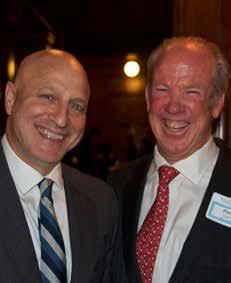
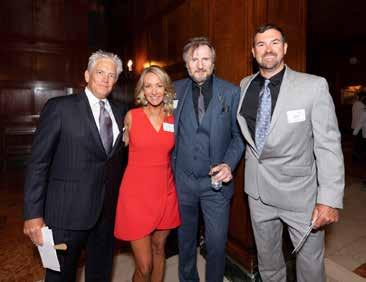







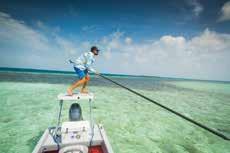


Anglers Journal is not your run-of-the-mill fishing mag. We created this publication for that special band of enthusiasts who feel most alive when they are on the water. This award-winning quarterly features gorgeous photography, great writing, art, adventure, commentary and more. Let us remind you why you first got hooked so deeply by this special world. Let Anglers Journal take you home.
SUBSCRIBE
Subscriptions are $29 for four issues (Winter, Spring, Summer, Fall). Call (800) 877-5207 anglersjournal.com















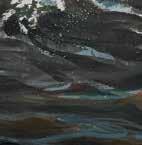

Gordy & Sons proudly support the Bonefish & Tarpon Trust




